1、回顾MVC
1.1、什么是MVC
-
MVC是模型(Model)、视图(View)、控制器(Controller)的简写,是一种软件设计规范。
-
是将业务逻辑、数据、显示分离的方法来组织代码。
-
MVC主要作用是降低了视图与业务逻辑间的双向偶合。
-
MVC不是一种设计模式,MVC是一种架构模式。当然不同的MVC存在差异。
Model(模型):数据模型,提供要展示的数据,因此包含数据和行为,可以认为是领域模型或JavaBean组件(包含数据和行为),不过现在一般都分离开来:Value Object(数据Dao) 和 服务层(行为Service)。也就是模型提供了模型数据查询和模型数据的状态更新等功能,包括数据和业务。
View(视图):负责进行模型的展示,一般就是我们见到的用户界面,客户想看到的东西。
Controller(控制器):接收用户请求,委托给模型进行处理(状态改变),处理完毕后把返回的模型数据返回给视图,由视图负责展示。也就是说控制器做了个调度员的工作。
最典型的MVC就是JSP + servlet + javabean的模式。

1.2、Model1时代
-
在web早期的开发中,通常采用的都是Model1。
-
Model1中,主要分为两层,视图层和模型层。
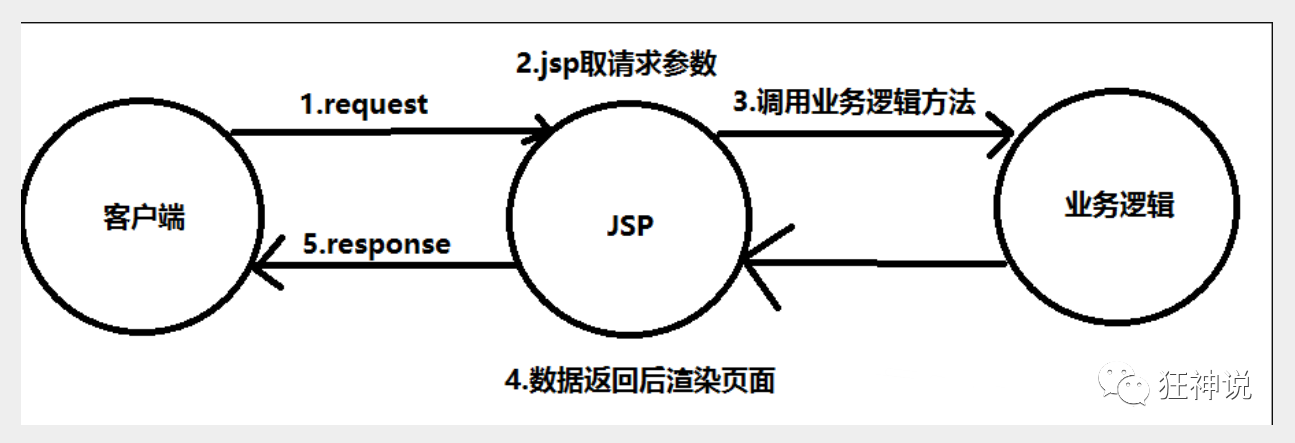
Model1优点:架构简单,比较适合小型项目开发;
Model1缺点:JSP职责不单一,职责过重,不便于维护;
1.3、Model2时代
Model2把一个项目分成三部分,包括视图、控制、模型。
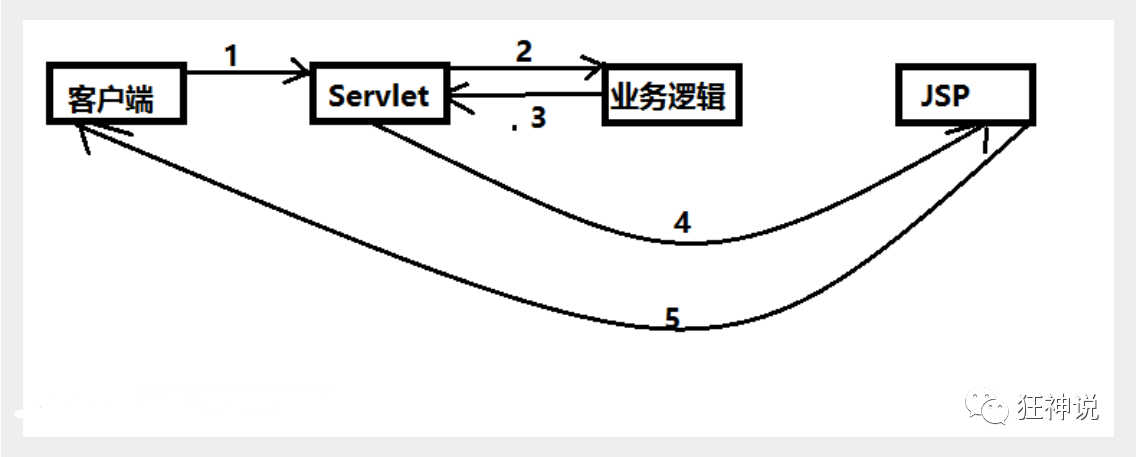
-
用户发请求
-
Servlet接收请求数据,并调用对应的业务逻辑方法
-
业务处理完毕,返回更新后的数据给servlet
-
servlet转向到JSP,由JSP来渲染页面
-
响应给前端更新后的页面
职责分析:
Controller:控制器
-
取得表单数据
-
调用业务逻辑
-
转向指定的页面
Model:模型
-
业务逻辑
-
保存数据的状态
View:视图
-
显示页面
Model2这样不仅提高的代码的复用率与项目的扩展性,且大大降低了项目的维护成本。Model 1模式的实现比较简单,适用于快速开发小规模项目,Model1中JSP页面身兼View和Controller两种角色,将控制逻辑和表现逻辑混杂在一起,从而导致代码的重用性非常低,增加了应用的扩展性和维护的难度。Model2消除了Model1的缺点。
1.4、回顾Servlet
-
新建一个Maven工程当做父工程!pom依赖!
 View Code
View Code<dependencies> <dependency> <groupId>junit</groupId> <artifactId>junit</artifactId> <version>4.12</version> </dependency> <dependency> <groupId>org.springframework</groupId> <artifactId>spring-webmvc</artifactId> <version>5.1.9.RELEASE</version> </dependency> <dependency> <groupId>javax.servlet</groupId> <artifactId>servlet-api</artifactId> <version>2.5</version> </dependency> <dependency> <groupId>javax.servlet.jsp</groupId> <artifactId>jsp-api</artifactId> <version>2.2</version> </dependency> <dependency> <groupId>javax.servlet</groupId> <artifactId>jstl</artifactId> <version>1.2</version> </dependency> </dependencies> -
建立一个Moudle:springmvc-01-servlet , 添加Web app的支持!
-
导入servlet 和 jsp 的 jar 依赖
 View Code
View Code<dependency> <groupId>javax.servlet</groupId> <artifactId>servlet-api</artifactId> <version>2.5</version> </dependency> <dependency> <groupId>javax.servlet.jsp</groupId> <artifactId>jsp-api</artifactId> <version>2.2</version> </dependency>
-
编写一个Servlet类,用来处理用户的请求
 View Code
View Codepackage com.kuang.servlet; //实现Servlet接口 public class HelloServlet extends HttpServlet { @Override protected void doGet(HttpServletRequest req, HttpServletResponse resp) throwsServletException, IOException { //取得参数 String method = req.getParameter("method"); if (method.equals("add")){ req.getSession().setAttribute("msg","执行了add方法"); } if (method.equals("delete")){ req.getSession().setAttribute("msg","执行了delete方法"); } //业务逻辑 //视图跳转 req.getRequestDispatcher("/WEB-INF/jsp/hello.jsp").forward(req,resp); } @Override protected void doPost(HttpServletRequest req, HttpServletResponse resp) throwsServletException, IOException { doGet(req,resp); } }
-
编写Hello.jsp,在WEB-INF目录下新建一个jsp的文件夹,新建hello.jsp
 View Code
View Code<%@ page contentType="text/html;charset=UTF-8" language="java" %> <html> <head> <title>Kuangshen</title> </head> <body> ${msg} </body> </html> -
在web.xml中注册Servlet
 View Code
View Code<?xml version="1.0" encoding="UTF-8"?> <web-app xmlns="http://xmlns.jcp.org/xml/ns/javaee" xmlns:xsi="http://www.w3.org/2001/XMLSchema-instance" xsi:schemaLocation="http://xmlns.jcp.org/xml/ns/javaee http://xmlns.jcp.org/xml/ns/javaee/web-app_4_0.xsd" version="4.0"> <servlet> <servlet-name>HelloServlet</servlet-name> <servlet-class>com.kuang.servlet.HelloServlet</servlet-class> </servlet> <servlet-mapping> <servlet-name>HelloServlet</servlet-name> <url-pattern>/user</url-pattern> </servlet-mapping> </web-app>
-
配置Tomcat,并启动测试

localhost:8080/user?method=add
localhost:8080/user?method=delete
MVC框架要做哪些事情
-
将url映射到java类或java类的方法 .
-
封装用户提交的数据 .
-
处理请求--调用相关的业务处理--封装响应数据 .
-
将响应的数据进行渲染 . jsp / html 等表示层数据 .
说明:
常见的服务器端MVC框架有:Struts、Spring MVC、ASP.NET MVC、Zend Framework、JSF;常见前端MVC框架:vue、angularjs、react、backbone;由MVC演化出了另外一些模式如:MVP、MVVM 等等....
2、什么是SpringMVC
2.1、概述
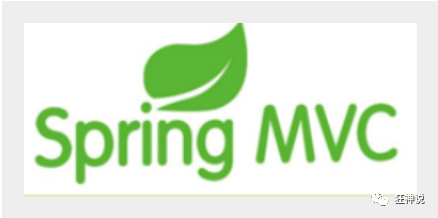
Spring MVC是Spring Framework的一部分,是基于Java实现MVC的轻量级Web框架。
查看官方文档:https://docs.spring.io/spring/docs/5.2.0.RELEASE/spring-framework-reference/web.html#spring-web
我们为什么要学习SpringMVC呢?
Spring MVC的特点:
-
轻量级,简单易学
-
高效 , 基于请求响应的MVC框架
-
与Spring兼容性好,无缝结合
-
约定优于配置
-
功能强大:RESTful、数据验证、格式化、本地化、主题等
-
简洁灵活
Spring的web框架围绕DispatcherServlet [ 调度Servlet ] 设计。
DispatcherServlet的作用是将请求分发到不同的处理器。从Spring 2.5开始,使用Java 5或者以上版本的用户可以采用基于注解形式进行开发,十分简洁;
正因为SpringMVC好 , 简单 , 便捷 , 易学 , 天生和Spring无缝集成(使用SpringIoC和Aop) , 使用约定优于配置 . 能够进行简单的junit测试 . 支持Restful风格 .异常处理 , 本地化 , 国际化 , 数据验证 , 类型转换 , 拦截器 等等......所以我们要学习 .
最重要的一点还是用的人多 , 使用的公司多 .
2.2、中心控制器
Spring的web框架围绕DispatcherServlet设计。DispatcherServlet的作用是将请求分发到不同的处理器。从Spring 2.5开始,使用Java 5或者以上版本的用户可以采用基于注解的controller声明方式。
Spring MVC框架像许多其他MVC框架一样, 以请求为驱动 , 围绕一个中心Servlet分派请求及提供其他功能,DispatcherServlet是一个实际的Servlet (它继承自HttpServlet 基类)。
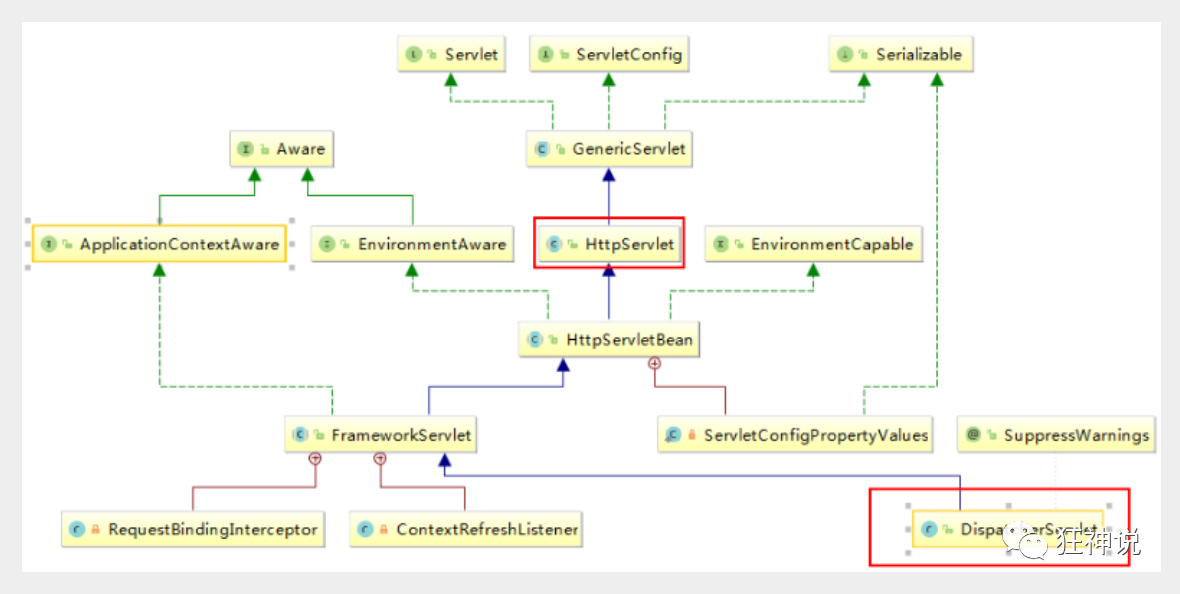
SpringMVC的原理如下图所示:
当发起请求时被前置的控制器拦截到请求,根据请求参数生成代理请求,找到请求对应的实际控制器,控制器处理请求,创建数据模型,访问数据库,将模型响应给中心控制器,控制器使用模型与视图渲染视图结果,将结果返回给中心控制器,再将结果返回给请求者。

2.3、SpringMVC执行原理
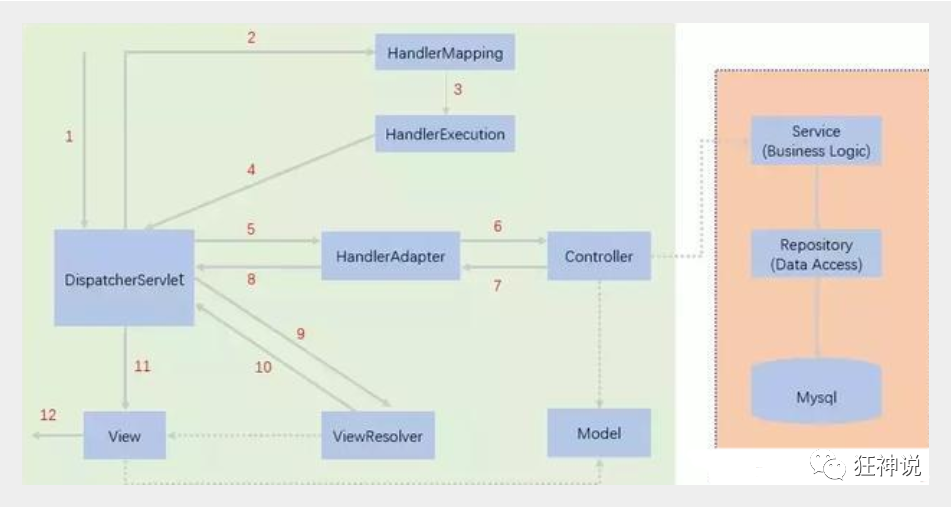
图为SpringMVC的一个较完整的流程图,实线表示SpringMVC框架提供的技术,不需要开发者实现,虚线表示需要开发者实现。
简要分析执行流程
-
DispatcherServlet表示前置控制器,是整个SpringMVC的控制中心。用户发出请求,DispatcherServlet接收请求并拦截请求。
我们假设请求的url为 : http://localhost:8080/SpringMVC/hello
如上url拆分成三部分:
http://localhost:8080服务器域名
SpringMVC部署在服务器上的web站点
hello表示控制器
通过分析,如上url表示为:请求位于服务器localhost:8080上的SpringMVC站点的hello控制器。
-
HandlerMapping为处理器映射。DispatcherServlet调用HandlerMapping,HandlerMapping根据请求url查找Handler。
-
HandlerExecution表示具体的Handler,其主要作用是根据url查找控制器,如上url被查找控制器为:hello。
-
HandlerExecution将解析后的信息传递给DispatcherServlet,如解析控制器映射等。
-
HandlerAdapter表示处理器适配器,其按照特定的规则去执行Handler。
-
Handler让具体的Controller执行。
-
Controller将具体的执行信息返回给HandlerAdapter,如ModelAndView。
-
HandlerAdapter将视图逻辑名或模型传递给DispatcherServlet。
-
DispatcherServlet调用视图解析器(ViewResolver)来解析HandlerAdapter传递的逻辑视图名。
-
视图解析器将解析的逻辑视图名传给DispatcherServlet。
-
DispatcherServlet根据视图解析器解析的视图结果,调用具体的视图。
-
最终视图呈现给用户。
第一个MVC程序
在上一节中,我们讲解了 什么是SpringMVC以及它的执行原理!
现在我们来看看如何快速使用SpringMVC编写我们的程序吧!
配置版
1、新建一个Moudle , springmvc-02-hello , 添加web的支持!
2、确定导入了SpringMVC 的依赖!
3、配置web.xml , 注册DispatcherServlet

<?xml version="1.0" encoding="UTF-8"?> <web-app xmlns="http://xmlns.jcp.org/xml/ns/javaee" xmlns:xsi="http://www.w3.org/2001/XMLSchema-instance" xsi:schemaLocation="http://xmlns.jcp.org/xml/ns/javaee http://xmlns.jcp.org/xml/ns/javaee/web-app_4_0.xsd" version="4.0"> <!--1.注册DispatcherServlet--> <servlet> <servlet-name>springmvc</servlet-name> <servlet-class>org.springframework.web.servlet.DispatcherServlet</servlet-class> <!--关联一个springmvc的配置文件:【servlet-name】-servlet.xml--> <init-param> <param-name>contextConfigLocation</param-name> <param-value>classpath:springmvc-servlet.xml</param-value> </init-param> <!--启动级别-1--> <load-on-startup>1</load-on-startup> </servlet> <!--/ 匹配所有的请求;(不包括.jsp)--> <!--/* 匹配所有的请求;(包括.jsp)--> <servlet-mapping> <servlet-name>springmvc</servlet-name> <url-pattern>/</url-pattern> </servlet-mapping> </web-app>
4、编写SpringMVC 的 配置文件!名称:springmvc-servlet.xml : [servletname]-servlet.xml
说明,这里的名称要求是按照官方来的

<?xml version="1.0" encoding="UTF-8"?> <beans xmlns="http://www.springframework.org/schema/beans" xmlns:xsi="http://www.w3.org/2001/XMLSchema-instance" xsi:schemaLocation="http://www.springframework.org/schema/beans http://www.springframework.org/schema/beans/spring-beans.xsd"> </beans>
5、添加 处理映射器
<bean class="org.springframework.web.servlet.handler.BeanNameUrlHandlerMapping"/>
6、添加 处理器适配器
<bean class="org.springframework.web.servlet.mvc.SimpleControllerHandlerAdapter"/>
7、添加 视图解析器
<!--视图解析器:DispatcherServlet给他的ModelAndView-->
<bean class="org.springframework.web.servlet.view.InternalResourceViewResolver" id="InternalResourceViewResolver">
<!--前缀-->
<property name="prefix" value="/WEB-INF/jsp/"/>
<!--后缀-->
<property name="suffix" value=".jsp"/>
</bean>
8、编写我们要操作业务Controller ,要么实现Controller接口,要么增加注解;需要返回一个ModelAndView,装数据,封视图;

package com.kuang.controller; import org.springframework.web.servlet.ModelAndView; import org.springframework.web.servlet.mvc.Controller; import javax.servlet.http.HttpServletRequest; import javax.servlet.http.HttpServletResponse; //注意:这里我们先导入Controller接口 public class HelloController implements Controller { public ModelAndView handleRequest(HttpServletRequest request, HttpServletResponse response) throws Exception { //ModelAndView 模型和视图 ModelAndView mv = new ModelAndView(); //封装对象,放在ModelAndView中。Model mv.addObject("msg","HelloSpringMVC!"); //封装要跳转的视图,放在ModelAndView中 mv.setViewName("hello"); //: /WEB-INF/jsp/hello.jsp return mv; } }
9、将自己的类交给SpringIOC容器,注册bean
<!--Handler-->
<bean id="/hello" class="com.kuang.controller.HelloController"/>
10、写要跳转的jsp页面,显示ModelandView存放的数据,以及我们的正常页面;

<%@ page contentType="text/html;charset=UTF-8" language="java" %>
<html>
<head>
<title>Kuangshen</title>
</head>
<body>
${msg}
</body>
</html
11、配置Tomcat 启动测试!

使用配置文件注册controller,每个controller实现controller方法,重写方法,这样每个接口对应一个控制器,太过繁琐?
注解则是可以对同一个controller进行注解扫描,无需过多配置,可以同时写入多个接口进行路由映射,十分方便,因此springmvc只推荐使用注解的方法。
可能遇到的问题:访问出现404,排查步骤:
-
查看控制台输出,看一下是不是缺少了什么jar包。
-
如果jar包存在,显示无法输出,就在IDEA的项目发布中,添加lib依赖!
-
重启Tomcat 即可解决!
小结:看这个估计大部分同学都能理解其中的原理了,但是我们实际开发才不会这么写,不然就疯了,还学这个玩意干嘛!我们来看个注解版实现,这才是SpringMVC的精髓,到底有多么简单,看这个图就知道了。

注解版
1、新建一个Moudle,springmvc-03-hello-annotation 。添加web支持!
2、由于Maven可能存在资源过滤的问题,我们将配置完善

<build>
<resources>
<resource>
<directory>src/main/java</directory>
<includes>
<include>**/*.properties</include>
<include>**/*.xml</include>
</includes>
<filtering>false</filtering>
</resource>
<resource>
<directory>src/main/resources</directory>
<includes>
<include>**/*.properties</include>
<include>**/*.xml</include>
</includes>
<filtering>false</filtering>
</resource>
</resources>
</build>
3、在pom.xml文件引入相关的依赖:主要有Spring框架核心库、Spring MVC、servlet , JSTL等。我们在父依赖中已经引入了!
4、配置web.xml
注意点:

<?xml version="1.0" encoding="UTF-8"?> <web-app xmlns="http://xmlns.jcp.org/xml/ns/javaee" xmlns:xsi="http://www.w3.org/2001/XMLSchema-instance" xsi:schemaLocation="http://xmlns.jcp.org/xml/ns/javaee http://xmlns.jcp.org/xml/ns/javaee/web-app_4_0.xsd" version="4.0"> <!--1.注册servlet--> <servlet> <servlet-name>SpringMVC</servlet-name> <servlet-class>org.springframework.web.servlet.DispatcherServlet</servlet-class> <!--通过初始化参数指定SpringMVC配置文件的位置,进行关联--> <init-param> <param-name>contextConfigLocation</param-name> <param-value>classpath:springmvc-servlet.xml</param-value> </init-param> <!-- 启动顺序,数字越小,启动越早 --> <load-on-startup>1</load-on-startup> </servlet> <!--所有请求都会被springmvc拦截 --> <servlet-mapping> <servlet-name>SpringMVC</servlet-name> <url-pattern>/</url-pattern> </servlet-mapping> </web-app>
/ 和 /* 的区别:< url-pattern > / </ url-pattern > 不会匹配到.jsp, 只针对我们编写的请求;即:.jsp 不会进入spring的 DispatcherServlet类 。< url-pattern > /* </ url-pattern > 会匹配 *.jsp,会出现返回 jsp视图 时再次进入spring的DispatcherServlet 类,导致找不到对应的controller所以报404错。
-
注意web.xml版本问题,要最新版!
-
注册DispatcherServlet
-
关联SpringMVC的配置文件
-
启动级别为1
-
映射路径为 / 【不要用/*,会404】
5、添加Spring MVC配置文件
- 在resource目录下添加springmvc-servlet.xml配置文件,配置的形式与Spring容器配置基本类似,为了支持基于注解的IOC,设置了自动扫描包的功能,具体配置信息如下:

<?xml version="1.0" encoding="UTF-8"?> <beans xmlns="http://www.springframework.org/schema/beans" xmlns:xsi="http://www.w3.org/2001/XMLSchema-instance" xmlns:context="http://www.springframework.org/schema/context" xmlns:mvc="http://www.springframework.org/schema/mvc" xsi:schemaLocation="http://www.springframework.org/schema/beans http://www.springframework.org/schema/beans/spring-beans.xsd http://www.springframework.org/schema/context https://www.springframework.org/schema/context/spring-context.xsd http://www.springframework.org/schema/mvc https://www.springframework.org/schema/mvc/spring-mvc.xsd"> <!-- 自动扫描包,让指定包下的注解生效,由IOC容器统一管理 --> <context:component-scan base-package="com.kuang.controller"/> <!-- 让Spring MVC不处理静态资源 --> <mvc:default-servlet-handler /> <!-- 支持mvc注解驱动 在spring中一般采用@RequestMapping注解来完成映射关系 要想使@RequestMapping注解生效 必须向上下文中注册DefaultAnnotationHandlerMapping 和一个AnnotationMethodHandlerAdapter实例 这两个实例分别在类级别和方法级别处理。 而annotation-driven配置帮助我们自动完成上述两个实例的注入。 --> <mvc:annotation-driven /> <!-- 视图解析器 --> <bean class="org.springframework.web.servlet.view.InternalResourceViewResolver" id="internalResourceViewResolver"> <!-- 前缀 --> <property name="prefix" value="/WEB-INF/jsp/" /> <!-- 后缀 --> <property name="suffix" value=".jsp" /> </bean> </beans>
-
在视图解析器中我们把所有的视图都存放在/WEB-INF/目录下,这样可以保证视图安全,因为这个目录下的文件,客户端不能直接访问。
-
让IOC的注解生效
-
静态资源过滤 :HTML . JS . CSS . 图片 , 视频 .....
-
MVC的注解驱动
-
配置视图解析器
6、创建Controller
编写一个Java控制类:com.kuang.controller.HelloController , 注意编码规范

package com.kuang.controller; import org.springframework.stereotype.Controller; import org.springframework.ui.Model; import org.springframework.web.bind.annotation.RequestMapping; @Controller @RequestMapping("/HelloController") public class HelloController { //真实访问地址 : 项目名/HelloController/hello @RequestMapping("/hello") public String sayHello(Model model){ //向模型中添加属性msg与值,可以在JSP页面中取出并渲染 model.addAttribute("msg","hello,SpringMVC"); //web-inf/jsp/hello.jsp return "hello"; } }
-
@Controller是为了让Spring IOC容器初始化时自动扫描到;
-
@RequestMapping是为了映射请求路径,这里因为类与方法上都有映射所以访问时应该是/HelloController/hello;
-
方法中声明Model类型的参数是为了把Action中的数据带到视图中;
-
方法返回的结果是视图的名称hello,加上配置文件中的前后缀变成WEB-INF/jsp/hello.jsp。
7、创建视图层
在WEB-INF/ jsp目录中创建hello.jsp , 视图可以直接取出并展示从Controller带回的信息;
可以通过EL表示取出Model中存放的值,或者对象;

<%@ page contentType="text/html;charset=UTF-8" language="java" %>
<html>
<head>
<title>SpringMVC</title>
</head>
<body>
${msg}
</body>
</html>

OK,运行成功!
小结
实现步骤其实非常的简单:
-
新建一个web项目
-
导入相关jar包
-
编写web.xml , 注册DispatcherServlet
-
编写springmvc配置文件
-
接下来就是去创建对应的控制类 , controller
-
最后完善前端视图和controller之间的对应
-
测试运行调试.
使用springMVC必须配置的三大件:
处理器映射器、处理器适配器、视图解析器
通常,我们只需要手动配置视图解析器,而处理器映射器和处理器适配器只需要开启注解驱动即可,而省去了大段的xml配置
再来回顾下原理吧~
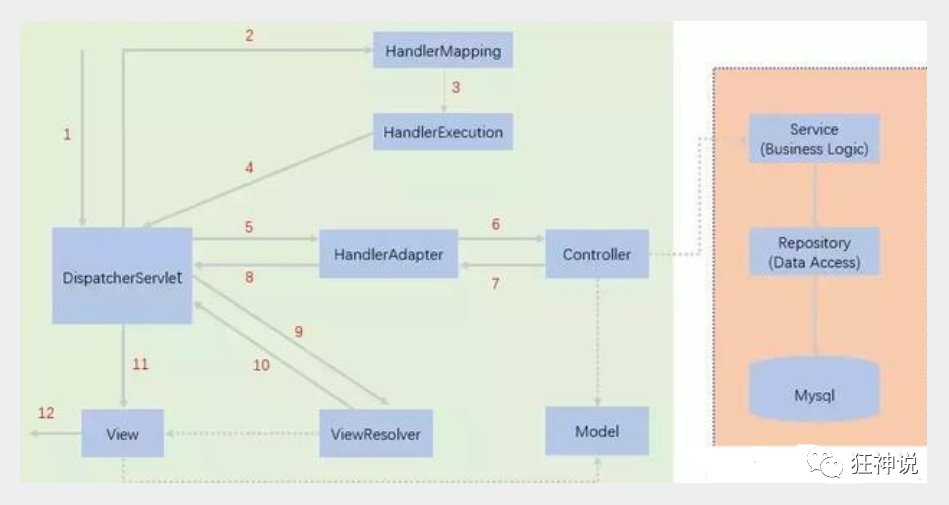
狂神说SpringMVC03:RestFul和控制器
在上一节中,我们编写了我们的第一个SpringMVC程序!
现在我们来看看里面的控制器和路径请求的具体内容吧!
控制器Controller
-
控制器复杂提供访问应用程序的行为,通常通过接口定义或注解定义两种方法实现。
-
控制器负责解析用户的请求并将其转换为一个模型。
-
在Spring MVC中一个控制器类可以包含多个方法
-
在Spring MVC中,对于Controller的配置方式有很多种
实现Controller接口
Controller是一个接口,在org.springframework.web.servlet.mvc包下,接口中只有一个方法;

//实现该接口的类获得控制器功能 public interface Controller { //处理请求且返回一个模型与视图对象 ModelAndView handleRequest(HttpServletRequest var1, HttpServletResponse var2) throws Exception; }
测试
-
新建一个Moudle,springmvc-04-controller 。将刚才的03 拷贝一份, 我们进行操作!
-
删掉HelloController
-
mvc的配置文件只留下 视图解析器!
-
编写一个Controller类,ControllerTest1
- //定义控制器 //注意点:不要导错包,实现Controller接口,重写方法; public class ControllerTest1 implements Controller { public ModelAndView handleRequest(HttpServletRequest httpServletRequest, HttpServletResponse httpServletResponse) throws Exception { //返回一个模型视图对象 ModelAndView mv = new ModelAndView(); mv.addObject("msg","Test1Controller"); mv.setViewName("test"); return mv; } }
- View Code
-
编写完毕后,去Spring配置文件中注册请求的bean;name对应请求路径,class对应处理请求的类
<bean name="/t1" class="com.kuang.controller.ControllerTest1"/> -
编写前端test.jsp,注意在WEB-INF/jsp目录下编写,对应我们的视图解析器
<%@ page contentType="text/html;charset=UTF-8" language="java" %>
<html>
<head>
<title>Kuangshen</title>
</head>
<body>
${msg}
</body>
</html> -
配置Tomcat运行测试,我这里没有项目发布名配置的就是一个 / ,所以请求不用加项目名,OK!

说明:
-
实现接口Controller定义控制器是较老的办法
-
缺点是:一个控制器中只有一个方法,如果要多个方法则需要定义多个Controller;定义的方式比较麻烦;
使用注解@Controller
-
@Controller注解类型用于声明Spring类的实例是一个控制器(在讲IOC时还提到了另外3个注解);
-
Spring可以使用扫描机制来找到应用程序中所有基于注解的控制器类,为了保证Spring能找到你的控制器,需要在配置文件中声明组件扫描。
<!-- 自动扫描指定的包,下面所有注解类交给IOC容器管理 -->
<context:component-scan base-package="com.kuang.controller"/> -
增加一个ControllerTest2类,使用注解实现;
 View Code
View Code//@Controller注解的类会自动添加到Spring上下文中 @Controller public class ControllerTest2{ //映射访问路径 @RequestMapping("/t2") public String index(Model model){ //Spring MVC会自动实例化一个Model对象用于向视图中传值 model.addAttribute("msg", "ControllerTest2"); //返回视图位置 return "test"; } }
-
运行tomcat测试

可以发现,我们的两个请求都可以指向一个视图,但是页面结果的结果是不一样的,从这里可以看出视图是被复用的,而控制器与视图之间是弱偶合关系。
注解方式是平时使用的最多的方式!
RequestMapping
@RequestMapping
-
@RequestMapping注解用于映射url到控制器类或一个特定的处理程序方法。可用于类或方法上。用于类上,表示类中的所有响应请求的方法都是以该地址作为父路径。
-
为了测试结论更加准确,我们可以加上一个项目名测试 myweb
-
只注解在方法上面
 View Code
View Code@Controller public class TestController { @RequestMapping("/h1") public String test(){ return "test"; } }
访问路径:http://localhost:8080 / 项目名 / h1
-
同时注解类与方法
 View Code
View Code@Controller @RequestMapping("/admin") public class TestController { @RequestMapping("/h1") public String test(){ return "test"; } }
访问路径:http://localhost:8080 / 项目名/ admin /h1 , 需要先指定类的路径再指定方法的路径;
RestFul 风格
概念
Restful就是一个资源定位及资源操作的风格。不是标准也不是协议,只是一种风格。基于这个风格设计的软件可以更简洁,更有层次,更易于实现缓存等机制。
功能
资源:互联网所有的事物都可以被抽象为资源
资源操作:使用POST、DELETE、PUT、GET,使用不同方法对资源进行操作。
分别对应 添加、 删除、修改、查询。
传统方式操作资源 :通过不同的参数来实现不同的效果!方法单一,post 和 get
http://127.0.0.1/item/queryItem.action?id=1 查询,GET
http://127.0.0.1/item/saveItem.action 新增,POST
http://127.0.0.1/item/updateItem.action 更新,POST
http://127.0.0.1/item/deleteItem.action?id=1 删除,GET或POST
使用RESTful操作资源 :可以通过不同的请求方式来实现不同的效果!如下:请求地址一样,但是功能可以不同!
http://127.0.0.1/item/1 查询,GET
http://127.0.0.1/item 新增,POST
http://127.0.0.1/item 更新,PUT
http://127.0.0.1/item/1 删除,DELETE
学习测试
-
在新建一个类 RestFulController
 View Code
View Code@Controller public class RestFulController { }
-
在Spring MVC中可以使用 @PathVariable 注解,让方法参数的值对应绑定到一个URI模板变量上。
 View Code
View Code@Controller public class RestFulController { //映射访问路径 @RequestMapping("/commit/{p1}/{p2}") public String index(@PathVariable int p1, @PathVariable int p2, Model model){ int result = p1+p2; //Spring MVC会自动实例化一个Model对象用于向视图中传值 model.addAttribute("msg", "结果:"+result); //返回视图位置 return "test"; } }
-
我们来测试请求查看下

-
思考:使用路径变量的好处?
-
使路径变得更加简洁;
-
获得参数更加方便,框架会自动进行类型转换。
-
通过路径变量的类型可以约束访问参数,如果类型不一样,则访问不到对应的请求方法,如这里访问是的路径是/commit/1/a,则路径与方法不匹配,而不会是参数转换失败。

-
我们来修改下对应的参数类型,再次测试
 View Code
View Code//映射访问路径 @RequestMapping("/commit/{p1}/{p2}") public String index(@PathVariable int p1, @PathVariable String p2, Model model){ String result = p1+p2; //Spring MVC会自动实例化一个Model对象用于向视图中传值 model.addAttribute("msg", "结果:"+result); //返回视图位置 return "test"; }

使用method属性指定请求类型
用于约束请求的类型,可以收窄请求范围。指定请求谓词的类型如GET, POST, HEAD, OPTIONS, PUT, PATCH, DELETE, TRACE等
我们来测试一下:
-
增加一个方法
 View Code
View Code//映射访问路径,必须是POST请求 @RequestMapping(value = "/hello",method = {RequestMethod.POST}) public String index2(Model model){ model.addAttribute("msg", "hello!"); return "test"; }
-
我们使用浏览器地址栏进行访问默认是Get请求,会报错405:

-
如果将POST修改为GET则正常了;
 View Code
View Code//映射访问路径,必须是Get请求 @RequestMapping(value = "/hello",method = {RequestMethod.GET}) public String index2(Model model){ model.addAttribute("msg", "hello!"); return "test"; }
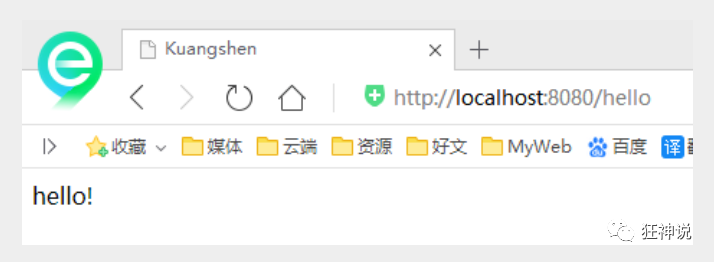
小结:
Spring MVC 的 @RequestMapping 注解能够处理 HTTP 请求的方法, 比如 GET, PUT, POST, DELETE 以及 PATCH。
所有的地址栏请求默认都会是 HTTP GET 类型的。
方法级别的注解变体有如下几个:组合注解
@GetMapping
@PostMapping
@PutMapping
@DeleteMapping
@PatchMapping@GetMapping 是一个组合注解,平时使用的会比较多!
它所扮演的是 @RequestMapping(method =RequestMethod.GET) 的一个快捷方式。
狂神说SpringMVC04:数据处理及跳转
-
在上一节中,我们了解了控制器和Restful风格操作
现在我们来看看SpringMVC参数接收处理和结果跳转处理吧!
结果跳转方式
ModelAndView
设置ModelAndView对象 , 根据view的名称 , 和视图解析器跳到指定的页面 .
页面 : {视图解析器前缀} + viewName +{视图解析器后缀}
<!-- 视图解析器 --> <bean class="org.springframework.web.servlet.view.InternalResourceViewResolver" id="internalResourceViewResolver"> <!-- 前缀 --> <property name="prefix" value="/WEB-INF/jsp/" /> <!-- 后缀 --> <property name="suffix" value=".jsp" /> </bean>
对应的controller类

public class ControllerTest1 implements Controller { public ModelAndView handleRequest(HttpServletRequest httpServletRequest,HttpServletResponse httpServletResponse) throws Exception { //返回一个模型视图对象 ModelAndView mv = new ModelAndView(); mv.addObject("msg","ControllerTest1"); mv.setViewName("test"); return mv; } }
ServletAPI
通过设置ServletAPI , 不需要视图解析器 .
1、通过HttpServletResponse进行输出
2、通过HttpServletResponse实现重定向
3、通过HttpServletResponse实现转发

@Controller public class ResultGo { @RequestMapping("/result/t1") public void test1(HttpServletRequest req, HttpServletResponse rsp) throwsIOException { rsp.getWriter().println("Hello,Spring BY servlet API"); } @RequestMapping("/result/t2") public void test2(HttpServletRequest req, HttpServletResponse rsp) throwsIOException { rsp.sendRedirect("/index.jsp"); } @RequestMapping("/result/t3") public void test3(HttpServletRequest req, HttpServletResponse rsp) throwsException { //转发 req.setAttribute("msg","/result/t3"); req.getRequestDispatcher("/WEB-INF/jsp/test.jsp").forward(req,rsp); } }
SpringMVC
通过SpringMVC来实现转发和重定向 - 无需视图解析器;
测试前,需要将视图解析器注释掉

@Controller public class ResultSpringMVC { @RequestMapping("/rsm/t1") public String test1(){ //转发 return "/index.jsp"; } @RequestMapping("/rsm/t2") public String test2(){ //转发二 return "forward:/index.jsp"; } @RequestMapping("/rsm/t3") public String test3(){ //重定向 return "redirect:/index.jsp"; } }
通过SpringMVC来实现转发和重定向 - 有视图解析器;
重定向 , 不需要视图解析器 , 本质就是重新请求一个新地方嘛 , 所以注意路径问题.
可以重定向到另外一个请求实现 .

@Controller public class ResultSpringMVC2 { @RequestMapping("/rsm2/t1") public String test1(){ //转发 return "test"; } @RequestMapping("/rsm2/t2") public String test2(){ //重定向 return "redirect:/index.jsp"; //return "redirect:hello.do"; //hello.do为另一个请求/ } }
数据处理
处理提交数据
1、提交的域名称和处理方法的参数名一致
提交数据 : http://localhost:8080/hello?name=kuangshen
处理方法 :

@RequestMapping("/hello")
public String hello(String name){
System.out.println(name);
return "hello";
}
后台输出 : kuangshen
2、提交的域名称和处理方法的参数名不一致
提交数据 : http://localhost:8080/hello?username=kuangshen
处理方法 :

//@RequestParam("username") : username提交的域的名称 . @RequestMapping("/hello") public String hello(@RequestParam("username") String name){ System.out.println(name); return "hello"; }
后台输出 : kuangshen
3、提交的是一个对象
要求提交的表单域和对象的属性名一致 , 参数使用对象即可
1、实体类

public class User { private int id; private String name; private int age; //构造 //get/set //tostring() }
2、提交数据 : http://localhost:8080/mvc04/user?name=kuangshen&id=1&age=15
3、处理方法 :

@RequestMapping("/user")
public String user(User user){
System.out.println(user);
return "hello";
}
后台输出 : User { id=1, name='kuangshen', age=15 }
说明:如果使用对象的话,前端传递的参数名和对象名必须一致,否则就是null。
数据显示到前端
第一种 : 通过ModelAndView
我们前面一直都是如此 . 就不过多解释

public class ControllerTest1 implements Controller { public ModelAndView handleRequest(HttpServletRequest httpServletRequest,HttpServletResponse httpServletResponse) throws Exception { //返回一个模型视图对象 ModelAndView mv = new ModelAndView(); mv.addObject("msg","ControllerTest1"); mv.setViewName("test"); return mv; } }
第二种 : 通过ModelMap
ModelMap

@RequestMapping("/hello")
public String hello(@RequestParam("username") String name, ModelMap model){
//封装要显示到视图中的数据
//相当于req.setAttribute("name",name);
model.addAttribute("name",name);
System.out.println(name);
return "hello";
}
第三种 : 通过Model
Model

@RequestMapping("/ct2/hello")
public String hello(@RequestParam("username") String name, Model model){
//封装要显示到视图中的数据
//相当于req.setAttribute("name",name);
model.addAttribute("msg",name);
System.out.println(name);
return "test";
}
对比
就对于新手而言简单来说使用区别就是:
Model 只有寥寥几个方法只适合用于储存数据,简化了新手对于Model对象的操作和理解;
ModelMap 继承了 LinkedMap ,除了实现了自身的一些方法,同样的继承 LinkedMap 的方法和特性;
ModelAndView 可以在储存数据的同时,可以进行设置返回的逻辑视图,进行控制展示层的跳转。
当然更多的以后开发考虑的更多的是性能和优化,就不能单单仅限于此的了解。
请使用80%的时间打好扎实的基础,剩下18%的时间研究框架,2%的时间去学点英文,框架的官方文档永远是最好的教程。
乱码问题
测试步骤:
1、我们可以在首页编写一个提交的表单

<form action="/e/t" method="post"> <input type="text" name="name"> <input type="submit"> </form>
2、后台编写对应的处理类

@Controller public class Encoding { @RequestMapping("/e/t") public String test(Model model,String name){ model.addAttribute("msg",name); //获取表单提交的值 return "test"; //跳转到test页面显示输入的值 } }
3、输入中文测试,发现乱码

不得不说,乱码问题是在我们开发中十分常见的问题,也是让我们程序猿比较头大的问题!
以前乱码问题通过过滤器解决 , 而SpringMVC给我们提供了一个过滤器 , 可以在web.xml中配置 .
修改了xml文件需要重启服务器!

<filter> <filter-name>encoding</filter-name> <filter-class>org.springframework.web.filter.CharacterEncodingFilter</filter-class> <init-param> <param-name>encoding</param-name> <param-value>utf-8</param-value> </init-param> </filter> <filter-mapping> <filter-name>encoding</filter-name> <url-pattern>/*</url-pattern> </filter-mapping>
但是我们发现 , 有些极端情况下.这个过滤器对get的支持不好 .
处理方法 :
1、修改tomcat配置文件 :设置编码!

<Connector URIEncoding="utf-8" port="8080" protocol="HTTP/1.1" connectionTimeout="20000" redirectPort="8443" />
2、自定义过滤器

package com.kuang.filter; import javax.servlet.*; import javax.servlet.http.HttpServletRequest; import javax.servlet.http.HttpServletRequestWrapper; import javax.servlet.http.HttpServletResponse; import java.io.IOException; import java.io.UnsupportedEncodingException; import java.util.Map; /** * 解决get和post请求 全部乱码的过滤器 */ public class GenericEncodingFilter implements Filter { @Override public void destroy() { } @Override public void doFilter(ServletRequest request, ServletResponse response, FilterChainchain) throws IOException, ServletException { //处理response的字符编码 HttpServletResponse myResponse=(HttpServletResponse) response; myResponse.setContentType("text/html;charset=UTF-8"); // 转型为与协议相关对象 HttpServletRequest httpServletRequest = (HttpServletRequest) request; // 对request包装增强 HttpServletRequest myrequest = new MyRequest(httpServletRequest); chain.doFilter(myrequest, response); } @Override public void init(FilterConfig filterConfig) throws ServletException { } } //自定义request对象,HttpServletRequest的包装类 class MyRequest extends HttpServletRequestWrapper { private HttpServletRequest request; //是否编码的标记 private boolean hasEncode; //定义一个可以传入HttpServletRequest对象的构造函数,以便对其进行装饰 public MyRequest(HttpServletRequest request) { super(request);// super必须写 this.request = request; } // 对需要增强方法 进行覆盖 @Override public Map getParameterMap() { // 先获得请求方式 String method = request.getMethod(); if (method.equalsIgnoreCase("post")) { // post请求 try { // 处理post乱码 request.setCharacterEncoding("utf-8"); return request.getParameterMap(); } catch (UnsupportedEncodingException e) { e.printStackTrace(); } } else if (method.equalsIgnoreCase("get")) { // get请求 Map<String, String[]> parameterMap = request.getParameterMap(); if (!hasEncode) { // 确保get手动编码逻辑只运行一次 for (String parameterName : parameterMap.keySet()) { String[] values = parameterMap.get(parameterName); if (values != null) { for (int i = 0; i < values.length; i++) { try { // 处理get乱码 values[i] = new String(values[i] .getBytes("ISO-8859-1"), "utf-8"); } catch (UnsupportedEncodingException e) { e.printStackTrace(); } } } } hasEncode = true; } return parameterMap; } return super.getParameterMap(); } //取一个值 @Override public String getParameter(String name) { Map<String, String[]> parameterMap = getParameterMap(); String[] values = parameterMap.get(name); if (values == null) { return null; } return values[0]; // 取回参数的第一个值 } //取所有值 @Override public String[] getParameterValues(String name) { Map<String, String[]> parameterMap = getParameterMap(); String[] values = parameterMap.get(name); return values; } }
这个也是我在网上找的一些大神写的,一般情况下,SpringMVC默认的乱码处理就已经能够很好的解决了!
然后在web.xml中配置这个过滤器即可!
乱码问题,需要平时多注意,在尽可能能设置编码的地方,都设置为统一编码 UTF-8!
整合SSM
环境要求
环境:
-
IDEA
-
MySQL 5.7.19
-
Tomcat 9
-
Maven 3.6
要求:
-
需要熟练掌握MySQL数据库,Spring,JavaWeb及MyBatis知识,简单的前端知识;
数据库环境
创建一个存放书籍数据的数据库表

CREATE DATABASE `ssmbuild`; USE `ssmbuild`; DROP TABLE IF EXISTS `books`; CREATE TABLE `books` ( `bookID` INT(10) NOT NULL AUTO_INCREMENT COMMENT '书id', `bookName` VARCHAR(100) NOT NULL COMMENT '书名', `bookCounts` INT(11) NOT NULL COMMENT '数量', `detail` VARCHAR(200) NOT NULL COMMENT '描述', KEY `bookID` (`bookID`) ) ENGINE=INNODB DEFAULT CHARSET=utf8 INSERT INTO `books`(`bookID`,`bookName`,`bookCounts`,`detail`)VALUES (1,'Java',1,'从入门到放弃'), (2,'MySQL',10,'从删库到跑路'), (3,'Linux',5,'从进门到进牢');
基本环境搭建
1、新建一Maven项目!ssmbuild , 添加web的支持
2、导入相关的pom依赖!

<dependencies>
<!--Junit-->
<dependency>
<groupId>junit</groupId>
<artifactId>junit</artifactId>
<version>4.12</version>
</dependency>
<!--数据库驱动-->
<dependency>
<groupId>mysql</groupId>
<artifactId>mysql-connector-java</artifactId>
<version>5.1.47</version>
</dependency>
<!-- 数据库连接池 -->
<dependency>
<groupId>com.mchange</groupId>
<artifactId>c3p0</artifactId>
<version>0.9.5.2</version>
</dependency>
<!--Servlet - JSP -->
<dependency>
<groupId>javax.servlet</groupId>
<artifactId>servlet-api</artifactId>
<version>2.5</version>
</dependency>
<dependency>
<groupId>javax.servlet.jsp</groupId>
<artifactId>jsp-api</artifactId>
<version>2.2</version>
</dependency>
<dependency>
<groupId>javax.servlet</groupId>
<artifactId>jstl</artifactId>
<version>1.2</version>
</dependency>
<!--Mybatis-->
<dependency>
<groupId>org.mybatis</groupId>
<artifactId>mybatis</artifactId>
<version>3.5.2</version>
</dependency>
<dependency>
<groupId>org.mybatis</groupId>
<artifactId>mybatis-spring</artifactId>
<version>2.0.2</version>
</dependency>
<!--Spring-->
<dependency>
<groupId>org.springframework</groupId>
<artifactId>spring-webmvc</artifactId>
<version>5.1.9.RELEASE</version>
</dependency>
<dependency>
<groupId>org.springframework</groupId>
<artifactId>spring-jdbc</artifactId>
<version>5.1.9.RELEASE</version>
</dependency>
</dependencies>
3、Maven资源过滤设置

<build>
<resources>
<resource>
<directory>src/main/java</directory>
<includes>
<include>**/*.properties</include>
<include>**/*.xml</include>
</includes>
<filtering>false</filtering>
</resource>
<resource>
<directory>src/main/resources</directory>
<includes>
<include>**/*.properties</include>
<include>**/*.xml</include>
</includes>
<filtering>false</filtering>
</resource>
</resources>
</build>
4、建立基本结构和配置框架!

com.kuang.pojo com.kuang.dao com.kuang.service com.kuang.controller mybatis-config.xml <?xml version="1.0" encoding="UTF-8" ?> <!DOCTYPE configuration PUBLIC "-//mybatis.org//DTD Config 3.0//EN" "http://mybatis.org/dtd/mybatis-3-config.dtd"> <configuration> </configuration> applicationContext.xml <?xml version="1.0" encoding="UTF-8"?> <beans xmlns="http://www.springframework.org/schema/beans" xmlns:xsi="http://www.w3.org/2001/XMLSchema-instance" xsi:schemaLocation="http://www.springframework.org/schema/beans http://www.springframework.org/schema/beans/spring-beans.xsd"> </beans>
Mybatis层编写
1、数据库配置文件 database.properties

jdbc.driver=com.mysql.jdbc.Driver jdbc.url=jdbc:mysql://localhost:3306/ssmbuild?useSSL=true&useUnicode=true&characterEncoding=utf8 jdbc.username=root jdbc.password=123456
2、IDEA关联数据库
3、编写MyBatis的核心配置文件

<?xml version="1.0" encoding="UTF-8" ?> <!DOCTYPE configuration PUBLIC "-//mybatis.org//DTD Config 3.0//EN" "http://mybatis.org/dtd/mybatis-3-config.dtd"> <configuration> <typeAliases> <package name="com.kuang.pojo"/> </typeAliases> <mappers> <mapper resource="com/kuang/dao/BookMapper.xml"/> </mappers> </configuration>
4、编写数据库对应的实体类 com.kuang.pojo.Books
使用lombok插件!

package com.kuang.pojo; import lombok.AllArgsConstructor; import lombok.Data; import lombok.NoArgsConstructor; @Data @AllArgsConstructor @NoArgsConstructor public class Books { private int bookID; private String bookName; private int bookCounts; private String detail; }
5、编写Dao层的 Mapper接口!

package com.kuang.dao; import com.kuang.pojo.Books; import java.util.List; public interface BookMapper { //增加一个Book int addBook(Books book); //根据id删除一个Book int deleteBookById(int id); //更新Book int updateBook(Books books); //根据id查询,返回一个Book Books queryBookById(int id); //查询全部Book,返回list集合 List<Books> queryAllBook(); }
6、编写接口对应的 Mapper.xml 文件。需要导入MyBatis的包;

<?xml version="1.0" encoding="UTF-8" ?> <!DOCTYPE mapper PUBLIC "-//mybatis.org//DTD Mapper 3.0//EN" "http://mybatis.org/dtd/mybatis-3-mapper.dtd"> <mapper namespace="com.kuang.dao.BookMapper"> <!--增加一个Book--> <insert id="addBook" parameterType="Books"> insert into ssmbuild.books(bookName,bookCounts,detail) values (#{bookName}, #{bookCounts}, #{detail}) </insert> <!--根据id删除一个Book--> <delete id="deleteBookById" parameterType="int"> delete from ssmbuild.books where bookID=#{bookID} </delete> <!--更新Book--> <update id="updateBook" parameterType="Books"> update ssmbuild.books set bookName = #{bookName},bookCounts = #{bookCounts},detail = #{detail} where bookID = #{bookID} </update> <!--根据id查询,返回一个Book--> <select id="queryBookById" resultType="Books"> select * from ssmbuild.books where bookID = #{bookID} </select> <!--查询全部Book--> <select id="queryAllBook" resultType="Books"> SELECT * from ssmbuild.books </select> </mapper>
7、编写Service层的接口和实现类
接口:

package com.kuang.service; import com.kuang.pojo.Books; import java.util.List; //BookService:底下需要去实现,调用dao层 public interface BookService { //增加一个Book int addBook(Books book); //根据id删除一个Book int deleteBookById(int id); //更新Book int updateBook(Books books); //根据id查询,返回一个Book Books queryBookById(int id); //查询全部Book,返回list集合 List<Books> queryAllBook(); }
实现类:

package com.kuang.service; import com.kuang.dao.BookMapper; import com.kuang.pojo.Books; import java.util.List; public class BookServiceImpl implements BookService { //调用dao层的操作,设置一个set接口,方便Spring管理 private BookMapper bookMapper; public void setBookMapper(BookMapper bookMapper) { this.bookMapper = bookMapper; } public int addBook(Books book) { return bookMapper.addBook(book); } public int deleteBookById(int id) { return bookMapper.deleteBookById(id); } public int updateBook(Books books) { return bookMapper.updateBook(books); } public Books queryBookById(int id) { return bookMapper.queryBookById(id); } public List<Books> queryAllBook() { return bookMapper.queryAllBook(); } }
OK,到此,底层需求操作编写完毕!
Spring层
1、配置Spring整合MyBatis,我们这里数据源使用c3p0连接池;
2、我们去编写Spring整合Mybatis的相关的配置文件;spring-dao.xml

<?xml version="1.0" encoding="UTF-8"?> <beans xmlns="http://www.springframework.org/schema/beans" xmlns:xsi="http://www.w3.org/2001/XMLSchema-instance" xmlns:context="http://www.springframework.org/schema/context" xsi:schemaLocation="http://www.springframework.org/schema/beans http://www.springframework.org/schema/beans/spring-beans.xsd http://www.springframework.org/schema/context https://www.springframework.org/schema/context/spring-context.xsd"> <!-- 配置整合mybatis --> <!-- 1.关联数据库文件 --> <context:property-placeholder location="classpath:database.properties"/> <!-- 2.数据库连接池 --> <!--数据库连接池 dbcp 半自动化操作 不能自动连接 c3p0 自动化操作(自动的加载配置文件 并且设置到对象里面) --> <bean id="dataSource" class="com.mchange.v2.c3p0.ComboPooledDataSource"> <!-- 配置连接池属性 --> <property name="driverClass" value="${jdbc.driver}"/> <property name="jdbcUrl" value="${jdbc.url}"/> <property name="user" value="${jdbc.username}"/> <property name="password" value="${jdbc.password}"/> <!-- c3p0连接池的私有属性 --> <property name="maxPoolSize" value="30"/> <property name="minPoolSize" value="10"/> <!-- 关闭连接后不自动commit --> <property name="autoCommitOnClose" value="false"/> <!-- 获取连接超时时间 --> <property name="checkoutTimeout" value="10000"/> <!-- 当获取连接失败重试次数 --> <property name="acquireRetryAttempts" value="2"/> </bean> <!-- 3.配置SqlSessionFactory对象 --> <bean id="sqlSessionFactory" class="org.mybatis.spring.SqlSessionFactoryBean"> <!-- 注入数据库连接池 --> <property name="dataSource" ref="dataSource"/> <!-- 配置MyBaties全局配置文件:mybatis-config.xml --> <property name="configLocation" value="classpath:mybatis-config.xml"/> </bean> <!-- 4.配置扫描Dao接口包,动态实现Dao接口注入到spring容器中 --> <!--解释 :https://www.cnblogs.com/jpfss/p/7799806.html--> <bean class="org.mybatis.spring.mapper.MapperScannerConfigurer"> <!-- 注入sqlSessionFactory --> <property name="sqlSessionFactoryBeanName" value="sqlSessionFactory"/> <!-- 给出需要扫描Dao接口包 --> <property name="basePackage" value="com.kuang.dao"/> </bean> </beans>
3、Spring整合service层

<?xml version="1.0" encoding="UTF-8"?> <beans xmlns="http://www.springframework.org/schema/beans" xmlns:xsi="http://www.w3.org/2001/XMLSchema-instance" xmlns:context="http://www.springframework.org/schema/context" xsi:schemaLocation="http://www.springframework.org/schema/beans http://www.springframework.org/schema/beans/spring-beans.xsd http://www.springframework.org/schema/context http://www.springframework.org/schema/context/spring-context.xsd"> <!-- 扫描service相关的bean --> <context:component-scan base-package="com.kuang.service" /> <!--BookServiceImpl注入到IOC容器中--> <bean id="BookServiceImpl" class="com.kuang.service.BookServiceImpl"> <property name="bookMapper" ref="bookMapper"/> </bean> <!-- 配置事务管理器 --> <bean id="transactionManager"class="org.springframework.jdbc.datasource.DataSourceTransactionManager"> <!-- 注入数据库连接池 --> <property name="dataSource" ref="dataSource" /> </bean> </beans>
Spring层搞定!再次理解一下,Spring就是一个大杂烩,一个容器!对吧!
SpringMVC层
1、web.xml

<?xml version="1.0" encoding="UTF-8"?> <web-app xmlns="http://xmlns.jcp.org/xml/ns/javaee" xmlns:xsi="http://www.w3.org/2001/XMLSchema-instance" xsi:schemaLocation="http://xmlns.jcp.org/xml/ns/javaee http://xmlns.jcp.org/xml/ns/javaee/web-app_4_0.xsd" version="4.0"> <!--DispatcherServlet--> <servlet> <servlet-name>DispatcherServlet</servlet-name> <servlet-class>org.springframework.web.servlet.DispatcherServlet</servlet-class> <init-param> <param-name>contextConfigLocation</param-name> <!--一定要注意:我们这里加载的是总的配置文件,之前被这里坑了!--> <param-value>classpath:applicationContext.xml</param-value> </init-param> <load-on-startup>1</load-on-startup> </servlet> <servlet-mapping> <servlet-name>DispatcherServlet</servlet-name> <url-pattern>/</url-pattern> </servlet-mapping> <!--encodingFilter--> <filter> <filter-name>encodingFilter</filter-name> <filter-class> org.springframework.web.filter.CharacterEncodingFilter </filter-class> <init-param> <param-name>encoding</param-name> <param-value>utf-8</param-value> </init-param> </filter> <filter-mapping> <filter-name>encodingFilter</filter-name> <url-pattern>/*</url-pattern> </filter-mapping> <!--Session过期时间--> <session-config> <session-timeout>15</session-timeout> </session-config> </web-app>
2、spring-mvc.xml

<?xml version="1.0" encoding="UTF-8"?> <beans xmlns="http://www.springframework.org/schema/beans" xmlns:xsi="http://www.w3.org/2001/XMLSchema-instance" xmlns:context="http://www.springframework.org/schema/context" xmlns:mvc="http://www.springframework.org/schema/mvc" xsi:schemaLocation="http://www.springframework.org/schema/beans http://www.springframework.org/schema/beans/spring-beans.xsd http://www.springframework.org/schema/context http://www.springframework.org/schema/context/spring-context.xsd http://www.springframework.org/schema/mvc https://www.springframework.org/schema/mvc/spring-mvc.xsd"> <!-- 配置SpringMVC --> <!-- 1.开启SpringMVC注解驱动 --> <mvc:annotation-driven /> <!-- 2.静态资源默认servlet配置--> <mvc:default-servlet-handler/> <!-- 3.配置jsp 显示ViewResolver视图解析器 --> <beanclass="org.springframework.web.servlet.view.InternalResourceViewResolver"> <property name="viewClass"value="org.springframework.web.servlet.view.JstlView" /> <property name="prefix" value="/WEB-INF/jsp/" /> <property name="suffix" value=".jsp" /> </bean> <!-- 4.扫描web相关的bean --> <context:component-scan base-package="com.kuang.controller" /> </beans>
3、Spring配置整合文件,applicationContext.xml

<?xml version="1.0" encoding="UTF-8"?> <beans xmlns="http://www.springframework.org/schema/beans" xmlns:xsi="http://www.w3.org/2001/XMLSchema-instance" xsi:schemaLocation="http://www.springframework.org/schema/beans http://www.springframework.org/schema/beans/spring-beans.xsd"> <import resource="spring-dao.xml"/> <import resource="spring-service.xml"/> <import resource="spring-mvc.xml"/> </beans>
配置文件,暂时结束!Controller 和 视图层编写
1、BookController 类编写 , 方法一:查询全部书籍

@Controller @RequestMapping("/book") public class BookController { @Autowired @Qualifier("BookServiceImpl") private BookService bookService; @RequestMapping("/allBook") public String list(Model model) { List<Books> list = bookService.queryAllBook(); model.addAttribute("list", list); return "allBook"; } }
2、编写首页 index.jsp

<%@ page language="java" contentType="text/html; charset=UTF-8"pageEncoding="UTF-8" %> <!DOCTYPE HTML> <html> <head> <title>首页</title> <style type="text/css"> a { text-decoration: none; color: black; font-size: 18px; } h3 { 180px; height: 38px; margin: 100px auto; text-align: center; line-height: 38px; background: deepskyblue; border-radius: 4px; } </style> </head> <body> <h3> <a href="${pageContext.request.contextPath}/book/allBook">点击进入列表页</a> </h3> </body> </html>
3、书籍列表页面 allbook.jsp

<%@ taglib prefix="c" uri="http://java.sun.com/jsp/jstl/core" %> <%@ page contentType="text/html;charset=UTF-8" language="java" %> <html> <head> <title>书籍列表</title> <meta name="viewport" content="width=device-width, initial-scale=1.0"> <!-- 引入 Bootstrap --> <link href="https://cdn.bootcss.com/bootstrap/3.3.7/css/bootstrap.min.css"rel="stylesheet"> </head> <body> <div class="container"> <div class="row clearfix"> <div class="col-md-12 column"> <div class="page-header"> <h1> <small>书籍列表 —— 显示所有书籍</small> </h1> </div> </div> </div> <div class="row"> <div class="col-md-4 column"> <a class="btn btn-primary"href="${pageContext.request.contextPath}/book/toAddBook">新增</a> </div> </div> <div class="row clearfix"> <div class="col-md-12 column"> <table class="table table-hover table-striped"> <thead> <tr> <th>书籍编号</th> <th>书籍名字</th> <th>书籍数量</th> <th>书籍详情</th> <th>操作</th> </tr> </thead> <tbody> <c:forEach var="book" items="${requestScope.get('list')}"> <tr> <td>${book.getBookID()}</td> <td>${book.getBookName()}</td> <td>${book.getBookCounts()}</td> <td>${book.getDetail()}</td> <td> <ahref="${pageContext.request.contextPath}/book/toUpdateBook?id=${book.getBookID()}">更改</a> | <ahref="${pageContext.request.contextPath}/book/del/${book.getBookID()}">删除</a> </td> </tr> </c:forEach> </tbody> </table> </div> </div> </div>
4、BookController 类编写 , 方法二:添加书籍

@RequestMapping("/toAddBook")
public String toAddPaper() {
return "addBook";
}
@RequestMapping("/addBook")
public String addPaper(Books books) {
System.out.println(books);
bookService.addBook(books);
return "redirect:/book/allBook";
}
5、添加书籍页面:addBook.jsp

<%@ taglib prefix="c" uri="http://java.sun.com/jsp/jstl/core" %> <%@ page contentType="text/html;charset=UTF-8" language="java" %> <html> <head> <title>新增书籍</title> <meta name="viewport" content="width=device-width, initial-scale=1.0"> <!-- 引入 Bootstrap --> <link href="https://cdn.bootcss.com/bootstrap/3.3.7/css/bootstrap.min.css"rel="stylesheet"> </head> <body> <div class="container"> <div class="row clearfix"> <div class="col-md-12 column"> <div class="page-header"> <h1> <small>新增书籍</small> </h1> </div> </div> </div> <form action="${pageContext.request.contextPath}/book/addBook"method="post"> 书籍名称:<input type="text" name="bookName"><br><br><br> 书籍数量:<input type="text" name="bookCounts"><br><br><br> 书籍详情:<input type="text" name="detail"><br><br><br> <input type="submit" value="添加"> </form> </div>
6、BookController 类编写 , 方法三:修改书籍

@RequestMapping("/toUpdateBook")
public String toUpdateBook(Model model, int id) {
Books books = bookService.queryBookById(id);
System.out.println(books);
model.addAttribute("book",books );
return "updateBook";
}
@RequestMapping("/updateBook")
public String updateBook(Model model, Books book) {
System.out.println(book);
bookService.updateBook(book);
Books books = bookService.queryBookById(book.getBookID());
model.addAttribute("books", books);
return "redirect:/book/allBook";
}
7、修改书籍页面 updateBook.jsp

<%@ taglib prefix="c" uri="http://java.sun.com/jsp/jstl/core" %> <%@ page contentType="text/html;charset=UTF-8" language="java" %> <html> <head> <title>修改信息</title> <meta name="viewport" content="width=device-width, initial-scale=1.0"> <!-- 引入 Bootstrap --> <link href="https://cdn.bootcss.com/bootstrap/3.3.7/css/bootstrap.min.css"rel="stylesheet"> </head> <body> <div class="container"> <div class="row clearfix"> <div class="col-md-12 column"> <div class="page-header"> <h1> <small>修改信息</small> </h1> </div> </div> </div> <form action="${pageContext.request.contextPath}/book/updateBook"method="post"> <input type="hidden" name="bookID" value="${book.getBookID()}"/> 书籍名称:<input type="text" name="bookName"value="${book.getBookName()}"/> 书籍数量:<input type="text" name="bookCounts"value="${book.getBookCounts()}"/> 书籍详情:<input type="text" name="detail" value="${book.getDetail() }"/> <input type="submit" value="提交"/> </form> </div>
8、BookController 类编写 , 方法四:删除书籍

@RequestMapping("/del/{bookId}")
public String deleteBook(@PathVariable("bookId") int id) {
bookService.deleteBookById(id);
return "redirect:/book/allBook";
}
配置Tomcat,进行运行!
到目前为止,这个SSM项目整合已经完全的OK了,可以直接运行进行测试!这个练习十分的重要,大家需要保证,不看任何东西,自己也可以完整的实现出来!
项目结构图
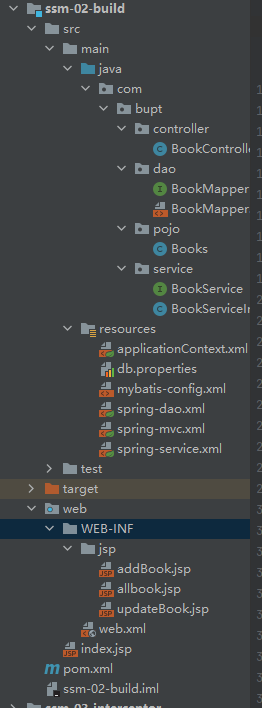
狂神说SpringMVC06:Json交互处理
什么是JSON?
-
JSON(JavaScript Object Notation, JS 对象标记) 是一种轻量级的数据交换格式,目前使用特别广泛。
-
采用完全独立于编程语言的文本格式来存储和表示数据。
-
简洁和清晰的层次结构使得 JSON 成为理想的数据交换语言。
-
易于人阅读和编写,同时也易于机器解析和生成,并有效地提升网络传输效率。
在 JavaScript 语言中,一切都是对象。因此,任何JavaScript 支持的类型都可以通过 JSON 来表示,例如字符串、数字、对象、数组等。看看他的要求和语法格式:
-
对象表示为键值对,数据由逗号分隔
-
花括号保存对象
-
方括号保存数组
JSON 键值对是用来保存 JavaScript 对象的一种方式,和 JavaScript 对象的写法也大同小异,键/值对组合中的键名写在前面并用双引号 "" 包裹,使用冒号 : 分隔,然后紧接着值:
{"name": "QinJiang"}
{"age": "3"}
{"sex": "男"}
很多人搞不清楚 JSON 和 JavaScript 对象的关系,甚至连谁是谁都不清楚。其实,可以这么理解:
JSON 是 JavaScript 对象的字符串表示法,它使用文本表示一个 JS 对象的信息,本质是一个字符串。
var obj = {a: 'Hello', b: 'World'}; //这是一个对象,注意键名也是可以使用引号包裹的
var json = '{"a": "Hello", "b": "World"}'; //这是一个 JSON 字符串,本质是一个字符串
JSON 和 JavaScript 对象互转
要实现从JSON字符串转换为JavaScript 对象,使用 JSON.parse() 方法:
var obj = JSON.parse('{"a": "Hello", "b": "World"}');
//结果是 {a: 'Hello', b: 'World'}
要实现从JavaScript 对象转换为JSON字符串,使用 JSON.stringify() 方法:
var json = JSON.stringify({a: 'Hello', b: 'World'});
//结果是 '{"a": "Hello", "b": "World"}'
代码测试
1、新建一个module ,springmvc-05-json , 添加web的支持
2、在web目录下新建一个 json-1.html , 编写测试内容

<!DOCTYPE html> <html lang="en"> <head> <meta charset="UTF-8"> <title>JSON_秦疆</title> </head> <body> <script type="text/javascript"> //编写一个js的对象 var user = { name:"秦疆", age:3, sex:"男" }; //将js对象转换成json字符串 var str = JSON.stringify(user); console.log(str); //将json字符串转换为js对象 var user2 = JSON.parse(str); console.log(user2.age,user2.name,user2.sex); </script> </body> </html>
3、在IDEA中使用浏览器打开,查看控制台输出!
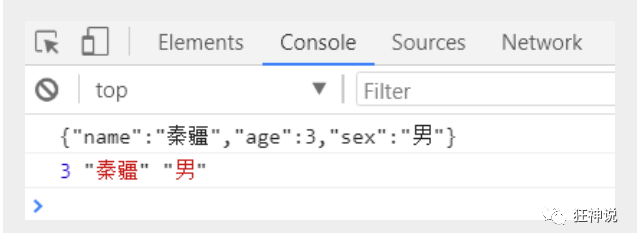
Controller返回JSON数据
Jackson应该是目前比较好的json解析工具了
当然工具不止这一个,比如还有阿里巴巴的 fastjson 等等。
我们这里使用Jackson,使用它需要导入它的jar包;

<!-- https://mvnrepository.com/artifact/com.fasterxml.jackson.core/jackson-core --> <dependency> <groupId>com.fasterxml.jackson.core</groupId> <artifactId>jackson-databind</artifactId> <version>2.9.8</version> </dependency>
配置SpringMVC需要的配置
web.xml

<?xml version="1.0" encoding="UTF-8"?> <web-app xmlns="http://xmlns.jcp.org/xml/ns/javaee" xmlns:xsi="http://www.w3.org/2001/XMLSchema-instance" xsi:schemaLocation="http://xmlns.jcp.org/xml/ns/javaee http://xmlns.jcp.org/xml/ns/javaee/web-app_4_0.xsd" version="4.0"> <!--1.注册servlet--> <servlet> <servlet-name>SpringMVC</servlet-name> <servlet-class>org.springframework.web.servlet.DispatcherServlet</servlet-class> <!--通过初始化参数指定SpringMVC配置文件的位置,进行关联--> <init-param> <param-name>contextConfigLocation</param-name> <param-value>classpath:springmvc-servlet.xml</param-value> </init-param> <!-- 启动顺序,数字越小,启动越早 --> <load-on-startup>1</load-on-startup> </servlet> <!--所有请求都会被springmvc拦截 --> <servlet-mapping> <servlet-name>SpringMVC</servlet-name> <url-pattern>/</url-pattern> </servlet-mapping> <filter> <filter-name>encoding</filter-name> <filter-class>org.springframework.web.filter.CharacterEncodingFilter</filter-class> <init-param> <param-name>encoding</param-name> <param-value>utf-8</param-value> </init-param> </filter> <filter-mapping> <filter-name>encoding</filter-name> <url-pattern>/</url-pattern> </filter-mapping> </web-app>
springmvc-servlet.xml

<?xml version="1.0" encoding="UTF-8"?> <beans xmlns="http://www.springframework.org/schema/beans" xmlns:xsi="http://www.w3.org/2001/XMLSchema-instance" xmlns:context="http://www.springframework.org/schema/context" xmlns:mvc="http://www.springframework.org/schema/mvc" xsi:schemaLocation="http://www.springframework.org/schema/beans http://www.springframework.org/schema/beans/spring-beans.xsd http://www.springframework.org/schema/context https://www.springframework.org/schema/context/spring-context.xsd http://www.springframework.org/schema/mvc https://www.springframework.org/schema/mvc/spring-mvc.xsd"> <!-- 自动扫描指定的包,下面所有注解类交给IOC容器管理 --> <context:component-scan base-package="com.kuang.controller"/> <!-- 视图解析器 --> <beanclass="org.springframework.web.servlet.view.InternalResourceViewResolver" id="internalResourceViewResolver"> <!-- 前缀 --> <property name="prefix" value="/WEB-INF/jsp/" /> <!-- 后缀 --> <property name="suffix" value=".jsp" /> </bean> </beans>
我们随便编写一个User的实体类,然后我们去编写我们的测试Controller;

package com.kuang.pojo; import lombok.AllArgsConstructor; import lombok.Data; import lombok.NoArgsConstructor; //需要导入lombok @Data @AllArgsConstructor @NoArgsConstructor public class User { private String name; private int age; private String sex; }
这里我们需要两个新东西,一个是@ResponseBody,一个是ObjectMapper对象,我们看下具体的用法
编写一个Controller;

@Controller public class UserController { @RequestMapping("/json1") @ResponseBody public String json1() throws JsonProcessingException { //创建一个jackson的对象映射器,用来解析数据 ObjectMapper mapper = new ObjectMapper(); //创建一个对象 User user = new User("秦疆1号", 3, "男"); //将我们的对象解析成为json格式 String str = mapper.writeValueAsString(user); //由于@ResponseBody注解,这里会将str转成json格式返回;十分方便 return str; } }
配置Tomcat , 启动测试一下!
http://localhost:8080/json1

发现出现了乱码问题,我们需要设置一下他的编码格式为utf-8,以及它返回的类型;
通过@RequestMaping的produces属性来实现,修改下代码
//produces:指定响应体返回类型和编码
@RequestMapping(value = "/json1",produces = "application/json;charset=utf-8")
再次测试, http://localhost:8080/json1 , 乱码问题OK!

【注意:使用json记得处理乱码问题】
代码优化
乱码统一解决
上一种方法比较麻烦,如果项目中有许多请求则每一个都要添加,可以通过Spring配置统一指定,这样就不用每次都去处理了!
我们可以在springmvc的配置文件上添加一段消息StringHttpMessageConverter转换配置!

<mvc:annotation-driven>
<mvc:message-converters register-defaults="true">
<beanclass="org.springframework.http.converter.StringHttpMessageConverter">
<constructor-arg value="UTF-8"/>
</bean>
<beanclass="org.springframework.http.converter.json.MappingJackson2HttpMessageConverter">
<property name="objectMapper">
<beanclass="org.springframework.http.converter.json.Jackson2ObjectMapperFactoryBean">
<property name="failOnEmptyBeans" value="false"/>
</bean>
</property>
</bean>
</mvc:message-converters>
</mvc:annotation-driven>
返回json字符串统一解决
在类上直接使用 @RestController ,这样子,里面所有的方法都只会返回 json 字符串了,不用再每一个都添加@ResponseBody !我们在前后端分离开发中,一般都使用 @RestController ,十分便捷!

@RestController public class UserController { //produces:指定响应体返回类型和编码 @RequestMapping(value = "/json1") public String json1() throws JsonProcessingException { //创建一个jackson的对象映射器,用来解析数据 ObjectMapper mapper = new ObjectMapper(); //创建一个对象 User user = new User("秦疆1号", 3, "男"); //将我们的对象解析成为json格式 String str = mapper.writeValueAsString(user); //由于@ResponseBody注解,这里会将str转成json格式返回;十分方便 return str; } }
启动tomcat测试,结果都正常输出!
测试集合输出
增加一个新的方法

@RequestMapping("/json2")
public String json2() throws JsonProcessingException {
//创建一个jackson的对象映射器,用来解析数据
ObjectMapper mapper = new ObjectMapper();
//创建一个对象
User user1 = new User("秦疆1号", 3, "男");
User user2 = new User("秦疆2号", 3, "男");
User user3 = new User("秦疆3号", 3, "男");
User user4 = new User("秦疆4号", 3, "男");
List<User> list = new ArrayList<User>();
list.add(user1);
list.add(user2);
list.add(user3);
list.add(user4);
//将我们的对象解析成为json格式
String str = mapper.writeValueAsString(list);
return str;
}
运行结果 : 十分完美,没有任何问题!

输出时间对象
增加一个新的方法

@RequestMapping("/json3")
public String json3() throws JsonProcessingException {
ObjectMapper mapper = new ObjectMapper();
//创建时间一个对象,java.util.Date
Date date = new Date();
//将我们的对象解析成为json格式
String str = mapper.writeValueAsString(date);
return str;
}
运行结果 :

-
默认日期格式会变成一个数字,是1970年1月1日到当前日期的毫秒数!
-
Jackson 默认是会把时间转成timestamps形式
解决方案:取消timestamps形式 , 自定义时间格式

@RequestMapping("/json4")
public String json4() throws JsonProcessingException {
ObjectMapper mapper = new ObjectMapper();
//不使用时间戳的方式
mapper.configure(SerializationFeature.WRITE_DATES_AS_TIMESTAMPS, false);
//自定义日期格式对象
SimpleDateFormat sdf = new SimpleDateFormat("yyyy-MM-dd HH:mm:ss");
//指定日期格式
mapper.setDateFormat(sdf);
Date date = new Date();
String str = mapper.writeValueAsString(date);
return str;
}
运行结果 : 成功的输出了时间!

抽取为工具类
如果要经常使用的话,这样是比较麻烦的,我们可以将这些代码封装到一个工具类中;我们去编写下

package com.kuang.utils; import com.fasterxml.jackson.core.JsonProcessingException; import com.fasterxml.jackson.databind.ObjectMapper; import com.fasterxml.jackson.databind.SerializationFeature; import java.text.SimpleDateFormat; public class JsonUtils { public static String getJson(Object object) { return getJson(object,"yyyy-MM-dd HH:mm:ss"); } public static String getJson(Object object,String dateFormat) { ObjectMapper mapper = new ObjectMapper(); //不使用时间差的方式 mapper.configure(SerializationFeature.WRITE_DATES_AS_TIMESTAMPS, false); //自定义日期格式对象 SimpleDateFormat sdf = new SimpleDateFormat(dateFormat); //指定日期格式 mapper.setDateFormat(sdf); try { return mapper.writeValueAsString(object); } catch (JsonProcessingException e) { e.printStackTrace(); } return null; } }
我们使用工具类,代码就更加简洁了!

@RequestMapping("/json5")
public String json5() throws JsonProcessingException {
Date date = new Date();
String json = JsonUtils.getJson(date);
return json;
}
大功告成!完美!
FastJson
fastjson.jar是阿里开发的一款专门用于Java开发的包,可以方便的实现json对象与JavaBean对象的转换,实现JavaBean对象与json字符串的转换,实现json对象与json字符串的转换。实现json的转换方法很多,最后的实现结果都是一样的。
fastjson 的 pom依赖!
<dependency>
<groupId>com.alibaba</groupId>
<artifactId>fastjson</artifactId>
<version>1.2.60</version>
</dependency>
fastjson 三个主要的类:
JSONObject 代表 json 对象
-
JSONObject实现了Map接口, 猜想 JSONObject底层操作是由Map实现的。
-
JSONObject对应json对象,通过各种形式的get()方法可以获取json对象中的数据,也可利用诸如size(),isEmpty()等方法获取"键:值"对的个数和判断是否为空。其本质是通过实现Map接口并调用接口中的方法完成的。
JSONArray 代表 json 对象数组
-
内部是有List接口中的方法来完成操作的。
JSON代表 JSONObject和JSONArray的转化
-
JSON类源码分析与使用
-
仔细观察这些方法,主要是实现json对象,json对象数组,javabean对象,json字符串之间的相互转化。
代码测试,我们新建一个FastJsonDemo 类

package com.kuang.controller; import com.alibaba.fastjson.JSON; import com.alibaba.fastjson.JSONObject; import com.kuang.pojo.User; import java.util.ArrayList; import java.util.List; public class FastJsonDemo { public static void main(String[] args) { //创建一个对象 User user1 = new User("秦疆1号", 3, "男"); User user2 = new User("秦疆2号", 3, "男"); User user3 = new User("秦疆3号", 3, "男"); User user4 = new User("秦疆4号", 3, "男"); List<User> list = new ArrayList<User>(); list.add(user1); list.add(user2); list.add(user3); list.add(user4); System.out.println("*******Java对象 转 JSON字符串*******"); String str1 = JSON.toJSONString(list); System.out.println("JSON.toJSONString(list)==>"+str1); String str2 = JSON.toJSONString(user1); System.out.println("JSON.toJSONString(user1)==>"+str2); System.out.println(" ****** JSON字符串 转 Java对象*******"); User jp_user1=JSON.parseObject(str2,User.class); System.out.println("JSON.parseObject(str2,User.class)==>"+jp_user1); System.out.println(" ****** Java对象 转 JSON对象 ******"); JSONObject jsonObject1 = (JSONObject) JSON.toJSON(user2); System.out.println("(JSONObject) JSON.toJSON(user2)==>"+jsonObject1.getString("name")); System.out.println(" ****** JSON对象 转 Java对象 ******"); User to_java_user = JSON.toJavaObject(jsonObject1, User.class); System.out.println("JSON.toJavaObject(jsonObject1, User.class)==>"+to_java_user); } }
这种工具类,我们只需要掌握使用就好了,在使用的时候在根据具体的业务去找对应的实现。和以前的commons-io那种工具包一样,拿来用就好了!
狂神说SpringMVC07:Ajax研究
简介
-
AJAX = Asynchronous JavaScript and XML(异步的 JavaScript 和 XML)。
-
AJAX 是一种在无需重新加载整个网页的情况下,能够更新部分网页的技术。
-
Ajax 不是一种新的编程语言,而是一种用于创建更好更快以及交互性更强的Web应用程序的技术。
-
在 2005 年,Google 通过其 Google Suggest 使 AJAX 变得流行起来。Google Suggest能够自动帮你完成搜索单词。
-
Google Suggest 使用 AJAX 创造出动态性极强的 web 界面:当您在谷歌的搜索框输入关键字时,JavaScript 会把这些字符发送到服务器,然后服务器会返回一个搜索建议的列表。
-
就和国内百度的搜索框一样!
-
传统的网页(即不用ajax技术的网页),想要更新内容或者提交一个表单,都需要重新加载整个网页。
-
使用ajax技术的网页,通过在后台服务器进行少量的数据交换,就可以实现异步局部更新。
-
使用Ajax,用户可以创建接近本地桌面应用的直接、高可用、更丰富、更动态的Web用户界面。
伪造Ajax
我们可以使用前端的一个标签来伪造一个ajax的样子。iframe标签
1、新建一个module :sspringmvc-06-ajax , 导入web支持!
2、编写一个 ajax-frame.html 使用 iframe 测试,感受下效果

<!DOCTYPE html> <html> <head lang="en"> <meta charset="UTF-8"> <title>kuangshen</title> </head> <body> <script type="text/javascript"> window.onload = function(){ var myDate = new Date(); document.getElementById('currentTime').innerText = myDate.getTime(); }; function LoadPage(){ var targetUrl = document.getElementById('url').value; console.log(targetUrl); document.getElementById("iframePosition").src = targetUrl; } </script> <div> <p>请输入要加载的地址:<span id="currentTime"></span></p> <p> <input id="url" type="text" value="https://www.baidu.com/"/> <input type="button" value="提交" onclick="LoadPage()"> </p> </div> <div> <h3>加载页面位置:</h3> <iframe id="iframePosition" style=" 100%;height: 500px;"></iframe> </div> </body> </html>
3、使用IDEA开浏览器测试一下!
利用AJAX可以做:
-
注册时,输入用户名自动检测用户是否已经存在。
-
登陆时,提示用户名密码错误
-
删除数据行时,将行ID发送到后台,后台在数据库中删除,数据库删除成功后,在页面DOM中将数据行也删除。
-
....等等
jQuery.ajax
纯JS原生实现Ajax我们不去讲解这里,直接使用jquery提供的,方便学习和使用,避免重复造轮子,有兴趣的同学可以去了解下JS原生XMLHttpRequest !
Ajax的核心是XMLHttpRequest对象(XHR)。XHR为向服务器发送请求和解析服务器响应提供了接口。能够以异步方式从服务器获取新数据。
jQuery 提供多个与 AJAX 有关的方法。
通过 jQuery AJAX 方法,您能够使用 HTTP Get 和 HTTP Post 从远程服务器上请求文本、HTML、XML 或 JSON – 同时您能够把这些外部数据直接载入网页的被选元素中。
jQuery 不是生产者,而是大自然搬运工。
jQuery Ajax本质就是 XMLHttpRequest,对他进行了封装,方便调用!

jQuery.ajax(...) 部分参数: url:请求地址 type:请求方式,GET、POST(1.9.0之后用method) headers:请求头 data:要发送的数据 contentType:即将发送信息至服务器的内容编码类型(默认: "application/x-www-form-urlencoded; charset=UTF-8") async:是否异步 timeout:设置请求超时时间(毫秒) beforeSend:发送请求前执行的函数(全局) complete:完成之后执行的回调函数(全局) success:成功之后执行的回调函数(全局) error:失败之后执行的回调函数(全局) accepts:通过请求头发送给服务器,告诉服务器当前客户端可接受的数据类型 dataType:将服务器端返回的数据转换成指定类型 "xml": 将服务器端返回的内容转换成xml格式 "text": 将服务器端返回的内容转换成普通文本格式 "html": 将服务器端返回的内容转换成普通文本格式,在插入DOM中时,如果包含JavaScript标签,则会尝试去执行。 "script": 尝试将返回值当作JavaScript去执行,然后再将服务器端返回的内容转换成普通文本格式 "json": 将服务器端返回的内容转换成相应的JavaScript对象 "jsonp": JSONP 格式使用 JSONP 形式调用函数时,如 "myurl?callback=?" jQuery 将自动替换 ? 为正确的函数名,以执行回调函数
我们来个简单的测试,使用最原始的HttpServletResponse处理 , .最简单 , 最通用
1、配置web.xml 和 springmvc的配置文件,复制上面案例的即可 【记得静态资源过滤和注解驱动配置上】

<?xml version="1.0" encoding="UTF-8"?> <beans xmlns="http://www.springframework.org/schema/beans" xmlns:xsi="http://www.w3.org/2001/XMLSchema-instance" xmlns:context="http://www.springframework.org/schema/context" xmlns:mvc="http://www.springframework.org/schema/mvc" xsi:schemaLocation="http://www.springframework.org/schema/beans http://www.springframework.org/schema/beans/spring-beans.xsd http://www.springframework.org/schema/context https://www.springframework.org/schema/context/spring-context.xsd http://www.springframework.org/schema/mvc https://www.springframework.org/schema/mvc/spring-mvc.xsd"> <!-- 自动扫描指定的包,下面所有注解类交给IOC容器管理 --> <context:component-scan base-package="com.kuang.controller"/> <mvc:default-servlet-handler /> <mvc:annotation-driven /> <!-- 视图解析器 --> <beanclass="org.springframework.web.servlet.view.InternalResourceViewResolver" id="internalResourceViewResolver"> <!-- 前缀 --> <property name="prefix" value="/WEB-INF/jsp/" /> <!-- 后缀 --> <property name="suffix" value=".jsp" /> </bean> </beans>
2、编写一个AjaxController

@Controller public class AjaxController { @RequestMapping("/a1") public void ajax1(String name , HttpServletResponse response) throws IOException{ if ("admin".equals(name)){ response.getWriter().print("true"); }else{ response.getWriter().print("false"); } } }
3、导入jquery , 可以使用在线的CDN , 也可以下载导入
<script src="https://code.jquery.com/jquery-3.1.1.min.js"></script>
<script src="${pageContext.request.contextPath}/statics/js/jquery-3.1.1.min.js"></script>
4、编写index.jsp测试

<%@ page contentType="text/html;charset=UTF-8" language="java" %>
<html>
<head>
<title>$Title$</title>
<%--<script src="https://code.jquery.com/jquery-3.1.1.min.js"></script>--%>
<script src="${pageContext.request.contextPath}/statics/js/jquery-3.1.1.min.js"></script>
<script>
function a1(){
$.post({
url:"${pageContext.request.contextPath}/a1",
data:{'name':$("#txtName").val()},
success:function (data,status) {
alert(data);
alert(status);
}
});
}
</script>
</head>
<body>
<%--onblur:失去焦点触发事件--%>
用户名:<input type="text" id="txtName" onblur="a1()"/>
</body>
</html>
5、启动tomcat测试!打开浏览器的控制台,当我们鼠标离开输入框的时候,可以看到发出了一个ajax的请求!是后台返回给我们的结果!测试成功!
Springmvc实现
实体类user

@Data @AllArgsConstructor @NoArgsConstructor public class User { private String name; private int age; private String sex; }
我们来获取一个集合对象,展示到前端页面

@RequestMapping("/a2")
public List<User> ajax2(){
List<User> list = new ArrayList<User>();
list.add(new User("秦疆1号",3,"男"));
list.add(new User("秦疆2号",3,"男"));
list.add(new User("秦疆3号",3,"男"));
return list; //由于@RestController注解,将list转成json格式返回
}
前端页面

<%@ page contentType="text/html;charset=UTF-8" language="java" %>
<html>
<head>
<title>Title</title>
</head>
<body>
<input type="button" id="btn" value="获取数据"/>
<table width="80%" align="center">
<tr>
<td>姓名</td>
<td>年龄</td>
<td>性别</td>
</tr>
<tbody id="content">
</tbody>
</table>
<script src="${pageContext.request.contextPath}/statics/js/jquery-3.1.1.min.js"></script>
<script>
$(function () {
$("#btn").click(function () {
$.post("${pageContext.request.contextPath}/a2",function (data) {
console.log(data)
var html="";
for (var i = 0; i <data.length ; i++) {
html+= "<tr>" +
"<td>" + data[i].name + "</td>" +
"<td>" + data[i].age + "</td>" +
"<td>" + data[i].sex + "</td>" +
"</tr>"
}
$("#content").html(html);
});
})
})
</script>
</body>
</html>
成功实现了数据回显!可以体会一下Ajax的好处!
注册提示效果
我们再测试一个小Demo,思考一下我们平时注册时候,输入框后面的实时提示怎么做到的;如何优化
我们写一个Controller

@RequestMapping("/a3")
public String ajax3(String name,String pwd){
String msg = "";
//模拟数据库中存在数据
if (name!=null){
if ("admin".equals(name)){
msg = "OK";
}else {
msg = "用户名输入错误";
}
}
if (pwd!=null){
if ("123456".equals(pwd)){
msg = "OK";
}else {
msg = "密码输入有误";
}
}
return msg; //由于@RestController注解,将msg转成json格式返回
}
前端页面 login.jsp

<%@ page contentType="text/html;charset=UTF-8" language="java" %>
<html>
<head>
<title>ajax</title>
<script src="${pageContext.request.contextPath}/statics/js/jquery-3.1.1.min.js"></script>
<script>
function a1(){
$.post({
url:"${pageContext.request.contextPath}/a3",
data:{'name':$("#name").val()},
success:function (data) {
if (data.toString()=='OK'){
$("#userInfo").css("color","green");
}else {
$("#userInfo").css("color","red");
}
$("#userInfo").html(data);
}
});
}
function a2(){
$.post({
url:"${pageContext.request.contextPath}/a3",
data:{'pwd':$("#pwd").val()},
success:function (data) {
if (data.toString()=='OK'){
$("#pwdInfo").css("color","green");
}else {
$("#pwdInfo").css("color","red");
}
$("#pwdInfo").html(data);
}
});
}
</script>
</head>
<body>
<p>
用户名:<input type="text" id="name" onblur="a1()"/>
<span id="userInfo"></span>
</p>
<p>
密码:<input type="text" id="pwd" onblur="a2()"/>
<span id="pwdInfo"></span>
</p>
</body>
</html>
【记得处理json乱码问题】
测试一下效果,动态请求响应,局部刷新,就是如此!

获取baidu接口Demo

<!DOCTYPE HTML> <html> <head> <meta http-equiv="Content-Type" content="text/html; charset=utf-8"> <title>JSONP百度搜索</title> <style> #q{ 500px; height: 30px; border:1px solid #ddd; line-height: 30px; display: block; margin: 0 auto; padding: 0 10px; font-size: 14px; } #ul{ 520px; list-style: none; margin: 0 auto; padding: 0; border:1px solid #ddd; margin-top: -1px; display: none; } #ul li{ line-height: 30px; padding: 0 10px; } #ul li:hover{ background-color: #f60; color: #fff; } </style> <script> // 2.步骤二 // 定义demo函数 (分析接口、数据) function demo(data){ var Ul = document.getElementById('ul'); var html = ''; // 如果搜索数据存在 把内容添加进去 if (data.s.length) { // 隐藏掉的ul显示出来 Ul.style.display = 'block'; // 搜索到的数据循环追加到li里 for(var i = 0;i<data.s.length;i++){ html += '<li>'+data.s[i]+'</li>'; } // 循环的li写入ul Ul.innerHTML = html; } } // 1.步骤一 window.onload = function(){ // 获取输入框和ul var Q = document.getElementById('q'); var Ul = document.getElementById('ul'); // 事件鼠标抬起时候 Q.onkeyup = function(){ // 如果输入框不等于空 if (this.value != '') { // ☆☆☆☆☆☆☆☆☆☆☆☆☆☆☆☆☆☆JSONPz重点☆☆☆☆☆☆☆☆☆☆☆☆☆☆☆☆☆☆☆☆ // 创建标签 var script = document.createElement('script'); //给定要跨域的地址 赋值给src //这里是要请求的跨域的地址 我写的是百度搜索的跨域地址 script.src ='https://sp0.baidu.com/5a1Fazu8AA54nxGko9WTAnF6hhy/su?wd='+this.value+'&cb=demo'; // 将组合好的带src的script标签追加到body里 document.body.appendChild(script); } } } </script> </head> <body> <input type="text" id="q" /> <ul id="ul"> </ul> </body> </html>
狂神说SpringMVC08:拦截器+文件上传下载
SpringMVC的处理器拦截器类似于Servlet开发中的过滤器Filter,用于对处理器进行预处理和后处理。开发者可以自己定义一些拦截器来实现特定的功能。
过滤器与拦截器的区别:拦截器是AOP思想的具体应用。
过滤器
-
servlet规范中的一部分,任何java web工程都可以使用
-
在url-pattern中配置了/*之后,可以对所有要访问的资源进行拦截
拦截器
-
拦截器是SpringMVC框架自己的,只有使用了SpringMVC框架的工程才能使用
-
拦截器只会拦截访问的控制器方法, 如果访问的是jsp/html/css/image/js是不会进行拦截的
自定义拦截器
那如何实现拦截器呢?
想要自定义拦截器,必须实现 HandlerInterceptor 接口。
1、新建一个Moudule , springmvc-07-Interceptor , 添加web支持
2、配置web.xml 和 springmvc-servlet.xml 文件
3、编写一个拦截器

package com.kuang.interceptor; import org.springframework.web.servlet.HandlerInterceptor; import org.springframework.web.servlet.ModelAndView; import javax.servlet.http.HttpServletRequest; import javax.servlet.http.HttpServletResponse; public class MyInterceptor implements HandlerInterceptor { //在请求处理的方法之前执行 //如果返回true执行下一个拦截器 //如果返回false就不执行下一个拦截器 public boolean preHandle(HttpServletRequest httpServletRequest,HttpServletResponse httpServletResponse, Object o) throws Exception { System.out.println("------------处理前------------"); return true; } //在请求处理方法执行之后执行 public void postHandle(HttpServletRequest httpServletRequest,HttpServletResponse httpServletResponse, Object o, ModelAndView modelAndView)throws Exception { System.out.println("------------处理后------------"); } //在dispatcherServlet处理后执行,做清理工作. public void afterCompletion(HttpServletRequest httpServletRequest,HttpServletResponse httpServletResponse, Object o, Exception e) throws Exception { System.out.println("------------清理------------"); } }
4、在springmvc的配置文件中配置拦截器

<!--关于拦截器的配置-->
<mvc:interceptors>
<mvc:interceptor>
<!--/** 包括路径及其子路径-->
<!--/admin/* 拦截的是/admin/add等等这种 , /admin/add/user不会被拦截-->
<!--/admin/** 拦截的是/admin/下的所有-->
<mvc:mapping path="/**"/>
<!--bean配置的就是拦截器-->
<bean class="com.kuang.interceptor.MyInterceptor"/>
</mvc:interceptor>
</mvc:interceptors>
5、编写一个Controller,接收请求

package com.kuang.controller; import org.springframework.stereotype.Controller; import org.springframework.web.bind.annotation.RequestMapping; import org.springframework.web.bind.annotation.ResponseBody; //测试拦截器的控制器 @Controller public class InterceptorController { @RequestMapping("/interceptor") @ResponseBody public String testFunction() { System.out.println("控制器中的方法执行了"); return "hello"; } }
6、前端 index.jsp
<a href="${pageContext.request.contextPath}/interceptor">拦截器测试</a>
7、启动tomcat 测试一下!
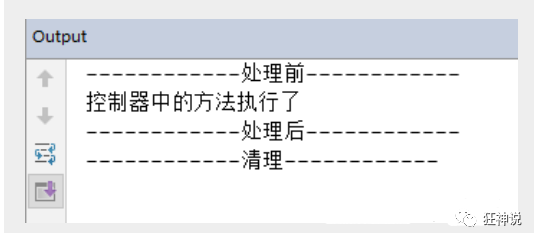
验证用户是否登录 (认证用户)
实现思路
1、有一个登陆页面,需要写一个controller访问页面。
2、登陆页面有一提交表单的动作。需要在controller中处理。判断用户名密码是否正确。如果正确,向session中写入用户信息。返回登陆成功。
3、拦截用户请求,判断用户是否登陆。如果用户已经登陆。放行, 如果用户未登陆,跳转到登陆页面
测试:
1、编写一个登陆页面 login.jsp

<%@ page contentType="text/html;charset=UTF-8" language="java" %>
<html>
<head>
<title>Title</title>
</head>
<h1>登录页面</h1>
<hr>
<body>
<form action="${pageContext.request.contextPath}/user/login">
用户名:<input type="text" name="username"> <br>
密码:<input type="password" name="pwd"> <br>
<input type="submit" value="提交">
</form>
</body>
</html>
2、编写一个Controller处理请求

package com.kuang.controller; import org.springframework.stereotype.Controller; import org.springframework.web.bind.annotation.RequestMapping; import javax.servlet.http.HttpSession; @Controller @RequestMapping("/user") public class UserController { //跳转到登陆页面 @RequestMapping("/jumplogin") public String jumpLogin() throws Exception { return "login"; } //跳转到成功页面 @RequestMapping("/jumpSuccess") public String jumpSuccess() throws Exception { return "success"; } //登陆提交 @RequestMapping("/login") public String login(HttpSession session, String username, String pwd) throwsException { // 向session记录用户身份信息 System.out.println("接收前端==="+username); session.setAttribute("user", username); return "success"; } //退出登陆 @RequestMapping("logout") public String logout(HttpSession session) throws Exception { // session 过期 session.invalidate(); return "login"; } }
3、编写一个登陆成功的页面 success.jsp

<%@ page contentType="text/html;charset=UTF-8" language="java" %>
<html>
<head>
<title>Title</title>
</head>
<body>
<h1>登录成功页面</h1>
<hr>
${user}
<a href="${pageContext.request.contextPath}/user/logout">注销</a>
</body>
</html>
4、在 index 页面上测试跳转!启动Tomcat 测试,未登录也可以进入主页!

<%@ page contentType="text/html;charset=UTF-8" language="java" %>
<html>
<head>
<title>$Title$</title>
</head>
<body>
<h1>首页</h1>
<hr>
<%--登录--%>
<a href="${pageContext.request.contextPath}/user/jumplogin">登录</a>
<a href="${pageContext.request.contextPath}/user/jumpSuccess">成功页面</a>
</body>
</html>
5、编写用户登录拦截器

package com.kuang.interceptor; import org.springframework.web.servlet.HandlerInterceptor; import org.springframework.web.servlet.ModelAndView; import javax.servlet.ServletException; import javax.servlet.http.HttpServletRequest; import javax.servlet.http.HttpServletResponse; import javax.servlet.http.HttpSession; import java.io.IOException; public class LoginInterceptor implements HandlerInterceptor { public boolean preHandle(HttpServletRequest request, HttpServletResponseresponse, Object handler) throws ServletException, IOException { // 如果是登陆页面则放行 System.out.println("uri: " + request.getRequestURI()); if (request.getRequestURI().contains("login")) { return true; } HttpSession session = request.getSession(); // 如果用户已登陆也放行 if(session.getAttribute("user") != null) { return true; } // 用户没有登陆跳转到登陆页面 request.getRequestDispatcher("/WEB-INF/jsp/login.jsp").forward(request,response); return false; } public void postHandle(HttpServletRequest httpServletRequest,HttpServletResponse httpServletResponse, Object o, ModelAndView modelAndView)throws Exception { } public void afterCompletion(HttpServletRequest httpServletRequest,HttpServletResponse httpServletResponse, Object o, Exception e) throws Exception { } }
6、在Springmvc的配置文件中注册拦截器
<!--关于拦截器的配置-->
<mvc:interceptors>
<mvc:interceptor>
<mvc:mapping path="/**"/>
<bean id="loginInterceptor" class="com.kuang.interceptor.LoginInterceptor"/>
</mvc:interceptor>
</mvc:interceptors>
7、再次重启Tomcat测试!
OK,测试登录拦截功能无误.
文件上传和下载
准备工作
文件上传是项目开发中最常见的功能之一 ,springMVC 可以很好的支持文件上传,但是SpringMVC上下文中默认没有装配MultipartResolver,因此默认情况下其不能处理文件上传工作。如果想使用Spring的文件上传功能,则需要在上下文中配置MultipartResolver。
前端表单要求:为了能上传文件,必须将表单的method设置为POST,并将enctype设置为multipart/form-data。只有在这样的情况下,浏览器才会把用户选择的文件以二进制数据发送给服务器;
对表单中的 enctype 属性做个详细的说明:
-
application/x-www=form-urlencoded:默认方式,只处理表单域中的 value 属性值,采用这种编码方式的表单会将表单域中的值处理成 URL 编码方式。
-
multipart/form-data:这种编码方式会以二进制流的方式来处理表单数据,这种编码方式会把文件域指定文件的内容也封装到请求参数中,不会对字符编码。
-
text/plain:除了把空格转换为 "+" 号外,其他字符都不做编码处理,这种方式适用直接通过表单发送邮件。
<form action="" enctype="multipart/form-data" method="post">
<input type="file" name="file"/>
<input type="submit">
</form>
一旦设置了enctype为multipart/form-data,浏览器即会采用二进制流的方式来处理表单数据,而对于文件上传的处理则涉及在服务器端解析原始的HTTP响应。在2003年,Apache Software Foundation发布了开源的Commons FileUpload组件,其很快成为Servlet/JSP程序员上传文件的最佳选择。
-
Servlet3.0规范已经提供方法来处理文件上传,但这种上传需要在Servlet中完成。
-
而Spring MVC则提供了更简单的封装。
-
Spring MVC为文件上传提供了直接的支持,这种支持是用即插即用的MultipartResolver实现的。
-
Spring MVC使用Apache Commons FileUpload技术实现了一个MultipartResolver实现类:
-
CommonsMultipartResolver。因此,SpringMVC的文件上传还需要依赖Apache Commons FileUpload的组件。
文件上传
1、导入文件上传的jar包,commons-fileupload , Maven会自动帮我们导入他的依赖包 commons-io包;

<!--文件上传--> <dependency> <groupId>commons-fileupload</groupId> <artifactId>commons-fileupload</artifactId> <version>1.3.3</version> </dependency> <!--servlet-api导入高版本的--> <dependency> <groupId>javax.servlet</groupId> <artifactId>javax.servlet-api</artifactId> <version>4.0.1</version> </dependency>
2、配置bean:multipartResolver
【注意!!!这个bena的id必须为:multipartResolver , 否则上传文件会报400的错误!在这里栽过坑,教训!】
<!--文件上传配置-->
<bean id="multipartResolver" class="org.springframework.web.multipart.commons.CommonsMultipartResolver">
<!-- 请求的编码格式,必须和jSP的pageEncoding属性一致,以便正确读取表单的内容,默认为ISO-8859-1 -->
<property name="defaultEncoding" value="utf-8"/>
<!-- 上传文件大小上限,单位为字节(10485760=10M) -->
<property name="maxUploadSize" value="10485760"/>
<property name="maxInMemorySize" value="40960"/>
</bean>
CommonsMultipartFile 的 常用方法:
-
String getOriginalFilename():获取上传文件的原名
-
InputStream getInputStream():获取文件流
-
void transferTo(File dest):将上传文件保存到一个目录文件中
我们去实际测试一下
3、编写前端页面
<form action="/upload" enctype="multipart/form-data" method="post">
<input type="file" name="file"/>
<input type="submit" value="upload">
</form>
4、Controller

package com.kuang.controller; import org.springframework.stereotype.Controller; import org.springframework.web.bind.annotation.RequestMapping; import org.springframework.web.bind.annotation.RequestParam; import org.springframework.web.multipart.commons.CommonsMultipartFile; import javax.servlet.http.HttpServletRequest; import java.io.*; @Controller public class FileController { //@RequestParam("file") 将name=file控件得到的文件封装成CommonsMultipartFile 对象 //批量上传CommonsMultipartFile则为数组即可 @RequestMapping("/upload") public String fileUpload(@RequestParam("file") CommonsMultipartFile file ,HttpServletRequest request) throws IOException { //获取文件名 : file.getOriginalFilename(); String uploadFileName = file.getOriginalFilename(); //如果文件名为空,直接回到首页! if ("".equals(uploadFileName)){ return "redirect:/index.jsp"; } System.out.println("上传文件名 : "+uploadFileName); //上传路径保存设置 String path = request.getServletContext().getRealPath("/upload"); //如果路径不存在,创建一个 File realPath = new File(path); if (!realPath.exists()){ realPath.mkdir(); } System.out.println("上传文件保存地址:"+realPath); InputStream is = file.getInputStream(); //文件输入流 OutputStream os = new FileOutputStream(new File(realPath,uploadFileName));//文件输出流 //读取写出 int len=0; byte[] buffer = new byte[1024]; while ((len=is.read(buffer))!=-1){ os.write(buffer,0,len); os.flush(); } os.close(); is.close(); return "redirect:/index.jsp"; } }
5、测试上传文件,OK!
采用file.Transto 来保存上传的文件
1、编写Controller

/* * 采用file.Transto 来保存上传的文件 */ @RequestMapping("/upload2") public String fileUpload2(@RequestParam("file") CommonsMultipartFile file,HttpServletRequest request) throws IOException { //上传路径保存设置 String path = request.getServletContext().getRealPath("/upload"); File realPath = new File(path); if (!realPath.exists()){ realPath.mkdir(); } //上传文件地址 System.out.println("上传文件保存地址:"+realPath); //通过CommonsMultipartFile的方法直接写文件(注意这个时候) file.transferTo(new File(realPath +"/"+ file.getOriginalFilename())); return "redirect:/index.jsp"; }
2、前端表单提交地址修改
3、访问提交测试,OK!
文件下载
文件下载步骤:
1、设置 response 响应头
2、读取文件 -- InputStream
3、写出文件 -- OutputStream
4、执行操作
5、关闭流 (先开后关)
代码实现:

@RequestMapping(value="/download") public String downloads(HttpServletResponse response ,HttpServletRequest request)throws Exception{ //要下载的图片地址 String path = request.getServletContext().getRealPath("/upload"); String fileName = "基础语法.jpg"; //1、设置response 响应头 response.reset(); //设置页面不缓存,清空buffer response.setCharacterEncoding("UTF-8"); //字符编码 response.setContentType("multipart/form-data"); //二进制传输数据 //设置响应头 response.setHeader("Content-Disposition", "attachment;fileName="+URLEncoder.encode(fileName, "UTF-8")); File file = new File(path,fileName); //2、 读取文件--输入流 InputStream input=new FileInputStream(file); //3、 写出文件--输出流 OutputStream out = response.getOutputStream(); byte[] buff =new byte[1024]; int index=0; //4、执行 写出操作 while((index= input.read(buff))!= -1){ out.write(buff, 0, index); out.flush(); } out.close(); input.close(); return null; }
前端
<a href="/download">点击下载</a>
测试,文件下载OK,大家可以和我们之前学习的JavaWeb原生的方式对比一下,就可以知道这个便捷多了!
